By Barry Briggs
Recently OpenAI open-sourced two Large Language Models (LLMs); seemingly moments later, those models were made available on Azure AI Foundry and on the AI community website Hugging Face.
What are open-source language models and what do they mean for enterprise usage and applications? And what is driving the urgency some feel in releasing open-source models?
Weight a Minute!
LLMs, at their core, are based on multi-layer neural networks. Each little circle in the (highly simplified) diagram below represents a “neuron,” a small amount of code; typical LLMs have hundreds of billions or even trillions of these – which is why highly parallelized GPUs are well-suited for LLM workloads. The key element of neurons is the “weight:” how much importance the model places on the result of each calculation in each neuron.
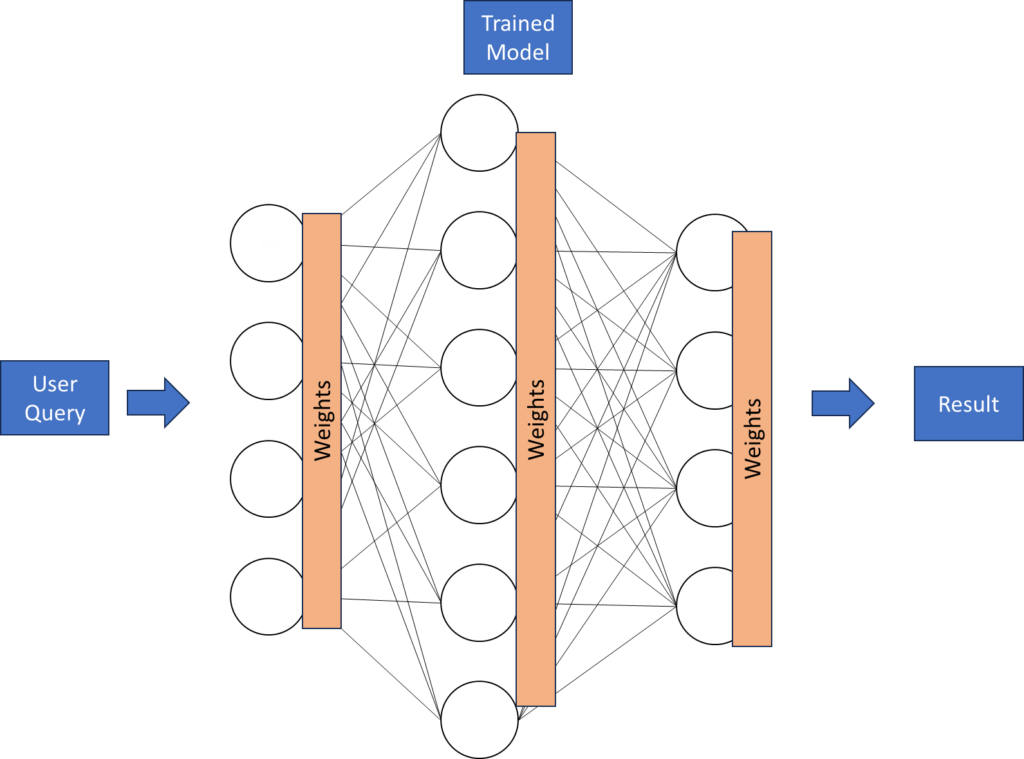
Think of the inferencing process as solving a large mathematical equation with billions of variables each “weighted” by a number, where A, B, and C and so on are the weights:

Here’s the point: the weights are the secret sauce, somewhat analogous to the source code, of LLMs, the core IP – and thus the models behind OpenAI’s ChatGPT were closed-source, specifically meaning the weights used in the 175-billion parameter model were not disclosed.
(There’s much, much more to it of course: current LLMs owe much of their efficacy to an epochal paper published in 2017 called “Attention is All You Need,” which described how data is consumed and transformed in models – hence “Generative Pretrained Transformer” or GPT. But I digress…)
Customizing Models
Enterprises quickly realized that LLMs could be incredibly powerful and useful within their applications and environments. But how to safely connect or integrate an LLM with potentially sensitive enterprise data?
RAGs
One of the first, and still perhaps the most prevalent approaches is called RAG, or Retrieval Augmented Generation. RAG apps, as they’re termed, connect models to data via search techniques.
 Here a model (hosted within the organization’s security boundary, such as an Azure tenant) parses the user’s question, extracts relevant terms, queries the connected HR application, and then formulates a natural-language response.
Here a model (hosted within the organization’s security boundary, such as an Azure tenant) parses the user’s question, extracts relevant terms, queries the connected HR application, and then formulates a natural-language response.
RAG apps are conceptually straightforward, relatively easy to create, and, if properly developed, secure. They are particularly useful for rapidly changing data such as news. However, the search process (which can involve multiple steps) can introduce latency and if the retrieved information is long, such as a multi-megabyte PDF, it can add expense (since costs are based on token count) and even overflow the LLM’s context window.
Fine Tuning a Closed Model
Fine tuning allows organizations to adjust the internal operation of the LLM itself. In fine tuning, developers “feed” enterprise data to an LLM (against, if using Azure, hosted inside the organizational tenant) having the effect of changing the LLM’s weights. That in turn (typically) creates a new instance of the model.
Fine tuning a closed-source model involves uploaded text or images in specific formats to the model via an API. It’s useful for scenarios in which specialized terminology such as medical or legal terms are needed, or enterprise-specific jargon such as product names and descriptions, equipment manuals, scientific writing, proprietary terminology, and in general in scenarios where the data does not change frequently. Morgan Stanley uses a fine-tuned LLM based on GPT-4 to assist its financial advisors with complex questions.

However, fine tuning closed models can incur costs – invoking the fine-tuning APIs can be expensive, and inferencing fine-tuned models generally comes with additional cost.
Finally, and perhaps most importantly, closed models such as GPT-4o cannot be hosted locally, that is, on-premises, precluding a number of important use cases: meaning that their use incurs cloud costs.
The Emergence – and Importance — of Open-Source Models
Open-source models are freely available, downloadable, and, most importantly, expose their weights directly for fine-tuning. In the last few years we’ve seen, perhaps somewhat surprisingly given the investment required to create them, numerous “open-source” models appear.
Open-source models can be fine-tuned (a process not dissimilar to training) locally on customer hardware – even on your PC – so that experimentation, testing, and deployment can happen inexpensively. Software encodes the input data (say, reference material of some sort) and then adjusts the weights of the model.
Thus, for example, dozens of fine-tuned LLMs have cropped up in nearly every aspect of healthcare and medicine (see a survey here); one, called Clinical Camel, uses a fine-tuned version of Meta’s LLaMa-2 model as a diagnostician, with impressive results. Other use cases include LLMs in edge computing, financial fraud detection, smart cities, eLearning, and manufacturing, among others.
While OpenAI published arguably the first open-source model, a reduced version of GPT-2 in 2019, it has since fallen behind: a tsunami of open-source models, many from China, have emerged. Indeed, when open-source DeepSeek (from Chinese firm High-Flyer) launched earlier this year with performance comparable to OpenAI’s latest models, markets briefly tumbled.
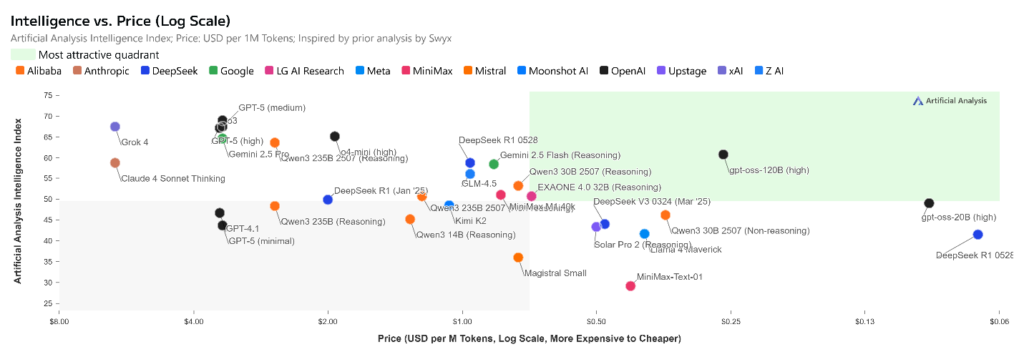
Which is why, finally, OpenAI’s release of open-source GPT models is significant, and why Microsoft was quick to incorporate them into Azure AI Foundry. Note, in the chart above from the (extraordinary) benchmarking site Artificial Analytics, that prior to gpt-oss’s launch, the top right quadrant would have been primarily populated with Chinese models: Alibaba’s Qwen, Minimax, DeepSeek, and ZAI (GLM).
The Geopolitics of It All
As early as 2017, China’s State Council declared AI a national priority. Many believe its development and promulgation of open-source models enables “soft-power” politics in developing countries that would otherwise be unwilling to pay for higher-priced models.
And the efficacy and popularity of these models has (some would say finally) gotten the attention of American government and industry. In rapid order came the White House’s “AI Action Plan” on July 23rd, the release of OpenAI’s gpt-oss models to great hoopla just days later, Microsoft’s announcement of their availability on AI Foundry, and the creation of the ATOM Project (American Truly Open Models) shortly thereafter (full disclosure: I am a signatory to ATOM).
Open, But Not Necessarily Free

(Microsoft sources: gpt-oss; gpt-5.
*Input charges may be less if prompts reused or cached.)
Now, squirreled away at the bottom of Microsoft’s announcement is the pricing of the gpt-oss models: that’s right, on Azure, the open-source models are not free! The larger of the two models costs $0.15/1 million input tokens and 60 cents per million output tokens; the smaller model, which can run on a single VM, is charged based on the VM cost. But – and here’s the deal – as we’ve said, these models can be downloaded and run for free on customer hardware.
Of course, OpenAI and Microsoft want to maintain some differentiation between open-source and premium, paid-for models; GPT-5 (on Azure, nearly 10x as expensive as gpt-oss, and not downloadable) supports many more features, has been extensively red-teamed, and is integrated with AI Foundry’s model router, a cost-saving feature.
What to make of all this?
A while back, I made the claim that models are increasingly commoditized. And with the emergence of open-source models customers can fine-tune them to meet the specific needs of their scenarios.
All this means there’s lots of choice, and customers will have decide which upon which criteria they choose their models. Will it be on the basis of cost? The ability to download them? The use of Responsible AI guardrails? National origin?
As is the case so often the answer is: it depends.
Think I need some fine-tuning? Drop me a line at bbriggs@directionsonmicrosoft.com.
No models were harmed in the creation of this blog post.

Microsoft has been working to move more customers off Enterprise Agreement (EA) volume licenses for the past few years. But it is really stepping up the war on the volume discounts on which these customers counted starting in Nov. 2025. Starting then, Microsoft will be discontinuing existing discounts for online services provided across all of its EA tiers, as well as for products covered by the Microsoft Products and Services Agreement (MPSA).
Volume-licensing customers of all sizes, especially larger customers earning larger discounts, could be hit with substantial price increases as a result. In practice, the biggest and most strategic Microsoft customers already are likely getting better deals than the built-in volume discounts by negotiating with Microsoft. But the change will likely mean that fewer customers will be able to count on guaranteed discounts, leading to more budget pressure.
Microsoft announced on August 12 plans to flatten these programmatic volume discounts across its online services — including Microsoft 365, Dynamics 365, Windows 365, and all security, compliance and identity management products. On-premises software products are not affected, and education and federal/state/local government customers are exempt.
Before this change, volume customers typically received discounts of anywhere from 6% to 12% on their online services purchased via EAs, with those purchasing more getting the biggest discounts. “Level D” customers which have 15,000+ users have received the automatic 12% discount on their EA services purchases. The coming Microsoft discount change – which we at Directions on Microsoft already are calling “Microsoft’s One Big Beautiful Licensing Announcement” — will affect Level B through D SKUs. Listed prices will be adjusted to match the Level A list price, which is the same as the Microsoft website price, according to Microsoft.
Microsoft’s official reason for the coming change in services discounts: “This update is part of Microsoft’s ongoing efforts to simplify licensing and improve pricing clarity for our customers.”
“With a standardized Online Services starting price for all customers across both Enterprise Agreement and Cloud Solution Provider, partners can invest time in pitching their value-added services instead of explaining the complexities of pricing structures,” explained Microsoft in an update to its volume-licensing hub on Microsoft Learn.
It’s All About the Money
But neither customers nor licensing experts buy that explanation. Instead, they say the move is part of Microsoft’s ongoing push to move all but the largest commercial customers from EAs to other types of channels like Microsoft Customer Agreements (MCAs) and MCAs for Enterprise (MCA-E).
Microsoft has been actively working to require smaller and mid-size customers to work with Cloud Solution Providers (CSPs), while grabbing the largest volume customers for itself. The thinking: By eliminating volume discounts and taking the biggest customers direct, Microsoft will be able to grow its services revenues faster.
For EA contracts which started on or before Oct. 1 2025, the no-programmatic discount rule kicks in only when, subsequent to Oct. 31 2025, customers add an online service that they had not previously purchased. For all EA contracts started on or after Nov. 1, the no-programmatic discount applies for all purchases.
In 2017, Microsoft dropped Azure price level discounts, and in 2018, it eliminated the volume discounts for its smaller volume-discount customers (known as Level A).
Microsoft’s rounds of layoffs during the first part of this year already meant that some customers lost their dedicated Microsoft account managers, noted Directions on Microsoft‘s Rob Horwitz. And the coming volume-licensing changes are going to make the situation even more confusing.
“Some programmatic discounts are being eliminated. The names of some things are changing. But the importance of and procedures for preparing for an upcoming contract negotiation remain largely unchanged ,” Horwitz said. “For example, it is still important to assemble and manage your internal contract negotiation team, clarify your current use and future needs for Microsoft products, understand the special concessions that you got last time that must be maintained, and develop financial models for various scenarios.”
And that’s where an advisory service like Directions on Microsoft can be invaluable to companies who are going to have to learn to navigate this new Microsoft licensing landscape, he added.
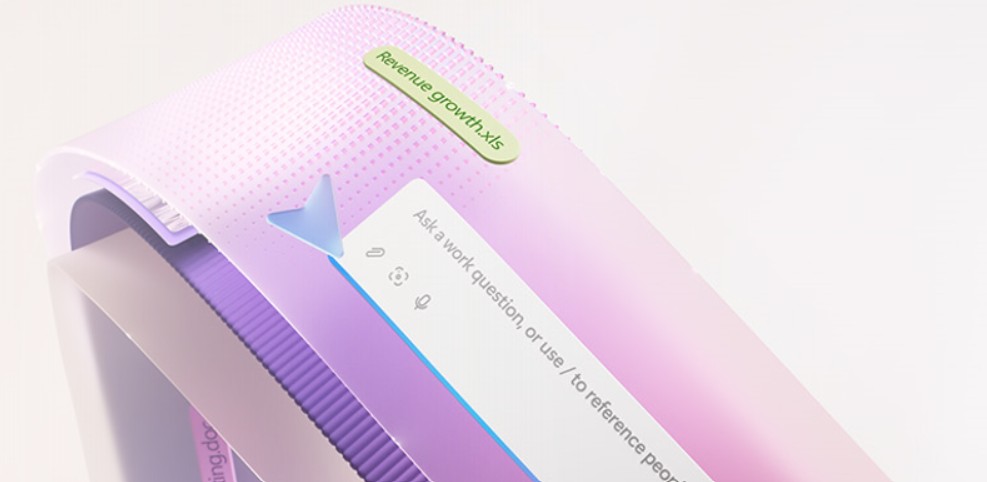
Microsoft beat its own and Wall Street’s expectations with its Q4 FY25 earnings, and the company’s stock price and market cap hit all-time highs this past week. Nice if you’re a shareholder or employee who survived the latest rounds of layoffs. But if you’re a Microsoft enterprise customer, what’s your takeaway from all this?
There are some clues in the numbers that Microsoft did — and didn’t — disclose in its Q4 report.
Azure, By the Numbers
For the first time ever, Microsoft provided an actual Azure revenue number as part of its Q4 report. For years, the company has declined to do so, speaking only in growth percentages without disclosing revenues, seemingly to prevent itself from being compared to AWS and Google Cloud.
Microsoft’s overall revenues for FY25 were $282 billion. Azure revenues were slightly less than half of the $168 billion in “Microsoft Cloud” revenue the company measured for fiscal 2025. (“Microsoft Cloud” is Microsoft’s own metric consisting of cloud revenues from Azure, Microsoft 365, Dynamics 365, some components of GitHub and LinkedIn and more.)
For its fiscal 2025, ending June 30, 2025, Azure and “other cloud services” surpassed $75 billion in revenue, up 34 percent year-over-year, Microsoft said, and it’s estimated to grow another 37% in Q1 FY26. Comparatively, AWS is at an annual revenue run rate of more than $123 billion, and Google Cloud at more than $50 billion.
Oddly, Microsoft’s latest earnings report didn’t disclose how much of its Azure revenue was attributable to AI. During the past several quarters, Microsoft provided either a number of points or a percentage of Azure revenues that came from AI workloads. Officials didn’t say why they decided against providing that figure this time around.
Microsoft execs instead emphasized that Azure revenues in FY25 were attributable across “all workloads.” They said Microsoft now has more than 400 datacenters across 70 regions, and that cloud demand remains higher than supply. In Q4 alone, Microsoft’s capital expenditures were $24.2 billion, with most of that going toward datacenter leases, servers, GPUs and other infrastructural components. Microsoft plans to continue to grow capex, predicting Q1 FY26 capex spending would hit $30 billion.
Microsoft 365: Numbers Shared and Not
Meanwhile, Microsoft 365 commercial had a strong Q4 as well, with revenues up 16%. Microsoft officials attributed seat growth primarily to new small-and-midsize businesses (SMBs) and frontline workers. They attributed growth in revenue per user to high-end E5 subscriptions, as well as Microsoft 365 Copilot.
Microsoft has not released an updated number as to what percentage of the Microsoft 365 commercial base is on E5 in years. In 2022, that number was just 12%. Each year since then, Microsoft sales has made migrating and upselling customers to E5 a priority.
Microsoft also has yet to release a number as to how many Microsoft 365 Copilot subscriptions it has sold. Instead, like it used to do with Azure before this quarter, Microsoft execs continue to provide difficult to quantify numbers about Copilot sales and adoption.
For example, officials said the company now has 100 million monthly active users “across our family of Copilots” in both the commercial and consumer space, but it’s not clear if this figure includes M365 Copilot Chat, which is free for business customers with M365 subscriptions. Microsoft also said GitHub Copilot now has 20 million users and the Dragon Copilot had 13 million “physician-patient encounters.” They added that Microsoft 365 Copilot saw “the largest quarter of seat adds since launch,” in Q4 FY25, and a record number of customers returning to buy more seats. But there was no actual Microsoft 365 Copilot number or any talk of revenues coming from M365 Copilot during the earnings call.
Reading the Earnings Tea Leaves
There are some takeaways from these numbers (and non-numbers) that are likely to affect enterprise customers in the coming year.
First, Microsoft’s pressure to adopt its various Copilots won’t be letting up. It’s a safe bet to assume adding more commercial Copilot seats and licenses will be a key part of any Microsoft licensing negotiation.
Ditto with the priciest Microsoft 365 tier. Microsoft and partners will continue their mission of getting even more customers to go with E5. Those who already are there should expect Microsoft to be pushing paid add-ons to their E5 subscriptions for things like Teams Premium, SharePoint Advanced Management (for the entire company, not just M365 Copilot users), etc.
Company officials noted on the earnings call that Microsoft Purview data governance and security tools are already used by three quarters of Microsoft 365 Copilot customers, but there’s still room for more add-ons there, too.
“Customer adoption of Copilot and AI is Microsoft’s biggest priority,” said Directions analyst Jim Gaynor. “And there will be the need for even more add-ons, as organizations realize they need things like Purview, SAM, and Azure AI Content Safety to complete the picture. Microsoft’s relying on that to keep increasing their revenue.”

Remember the introduction of ChatGPT on that momentous day in November 2022? Since then Copilots and chatbots have sprung up everywhere, social media is flooded with AI-generated posts, and enterprise-class agent-based applications are all the rage among techies and analysts. What an extraordinary time!
I was asked recently where AI, and for that matter, enterprise computing will be in five years. With the rapid pace of change it’s obviously more challenging than ever to say – but after some thought here’s where I came out.
No warranties or guarantees given or implied!
The Conservative View
I provided two possible views: a “conservative” one, in which AI is gradually and incrementally absorbed into the enterprise ecosystem, and a “radical” one in which AI changes everything.
The conservative view holds that, over time, applications absorb AI functionality, and we come to expect AI in all of them; in short, AI capabilities become an application convention just like, say, the Office ribbon or Copy/Paste. Copilots gradually improve. They connect to every application and data source in the enterprise in a safe, secure fashion (and as I describe in my discussion on data governance, protecting your data could in fact, occupy all five years!). Copilots live not just in Office but everywhere; perhaps Microsoft will even offer a “Copilot certification” for third-party apps to use its libraries and models and the Copilot trademark.
Less rote, pedestrian code is written by humans but, conversely, a higher premium is placed on developers and architects who can piece together the Copilot or Claude Code or Gemini code fragments into ever higher- and higher-value applications. Profound coding knowledge is still essential, but more and more developers check AI-generated code – rather than write it.
In this view, autonomous LLM-powered agents achieve a certain level of acceptance but (like Lotus Notes Agents, introduced way back in 1993) compete with existing and entrenched RPA apps. Moreover, users and enterprises, perhaps rightly, have limited trust in agents to perform mission-critical functions given their nondeterministic, statistical, probability-based nature and their tendency to hallucinate.
The Radical View
AI in this view changes everything in the next five years: we won’t recognize the new world of computing.
Imagine, for a moment, a contact center application completely comprised of agents.
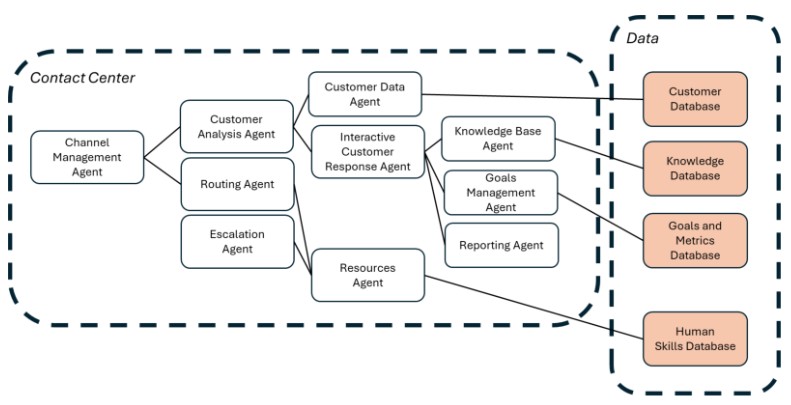
In this completely-made-up example, a Channel Agent manages the various customer contact channels (phone, email, etc.), perhaps assigning different priorities to regions at different times of the day. A Customer Analysis Agent identifies the customer and perhaps determines the likely cause of the call; a Routing Agent sends the call to either the agent or human most likely to successfully resolve it; and so on.
These agents are continuously trained on the vast amounts of (now well-governed) data in the enterprise, allowing them to quickly build and adapt data models, identify emerging trends and adjust business processes accordingly – and in general relieve IT of much of its traditional tedium.
IT Development in Flux
In theory, “developers” of the future create no procedural code; coding becomes a lost, or rare, art. Because all the agents are programmed, in effect, in English, the application can be completely customized to the very specific needs – indeed, nuances – of the organization, and (again in theory) could be easily changed as business needs mandate. There are no packaged ERP or CRM applications – rather, vendors provide infinitely customizable agents which IT teams with “SDKs” describing how to create the appropriate prompts.
Nevertheless, IT technologists remain a valuable and scarce resource. Profound knowledge of the inner workings of LLMs, the mechanics of exposing data safely and connecting LLMs to them, keeping these new ecosystems of agents and data secure, and creating the necessary goals and reward systems to achieve business goals: all these valuable new skills power the new IT.
What About Office?
Remember: the only reason Excel, PowerPoint, and Word are separate applications is because they were created in a time when PC memory maxed out at 640 kilobytes. Now most enterprise laptops sport (minimally) 16 gigabytes, or over 26,000 times that original, oh-so-primitive capacity.
Today, how many of you have all three open right now? (I do.) And we still need to know the silly, arcane, and dated methods of cutting-and-pasting between them. (Edit / Paste-Special? Really?)
So perhaps all the metaphors upon which we depend today undergo a growth spurt: with no need to respect hardware limitations, and LLMs’ extraordinary ability to quickly ascertain user intent, we no longer need separate applications for word processing, presentation graphics, and numerical analysis all possessing unintuitive menu hierarchies, quirky ribbons and distinct UIs.
In other words, could the Office apps dissolve and be replaced by…something else? A unified, all-in-one application for content creation, presentation and dissemination? (Maybe we’re already seeing the beginnings as OpenAI and Perplexity (and even Microsoft, sort of) introduce their own AI-native browsers).
Which Will It Be?
It’s my assertion that the mission of IT, ultimately, is to give control of the business to the business; that is, to enable, in real time, digital systems to respond to business leaders’ direction. Why couldn’t a CEO simply speak into some UI, “Decrease the price of our Widgets in Japan by 5% tomorrow – and provide an analysis the next day showing which market demographics and segments responded?”
So, which will get us there faster: incremental evolution or a revolution in IT? Of course, I don’t know – but I suspect we’ll see a continuing tension between a natural IT conservatism (if it works, don’t break it) set against the rapid, nonstop acceleration of AI – and the overarching necessity of driving competitive advantage.
Scary, fun, or just plain crazy? Drop me a line at bbriggs@directionsonmicrosoft.com and let me know what you think.

Microsoft recently announced SharePoint Advanced Management (SAM) was rolled into M365 Copilot licenses for no additional cost. Originally, Microsoft licensed SAM separately, so this is a big advantage for organizations wanting to roll out M365 Copilot.
Or is it?
Although Microsoft touts SAM as helping prepare organizations to deploy M365 Copilot, its tools are intended to identify and potentially resolve problem areas in SharePoint and OneDrive for Business and, consequently, is supposed to be licensed for everyone. As a result, this “no cost” pitch is creating confusion among customers. If organizations want to use SAM for rolling out M365 Copilot, does everyone in your organization need a M365 Copilot or a SAM license?
Microsoft is working to drive adoption of M365 Copilot, its flagship AI service, and knock down barriers to deploying it for its customers. Part of that strategy appears to be coupling SAM with M365 Copilot so that when an M365 Copilot license is purchased, SAM is enabled for the customer’s tenancy by default. This may not be a bad thing technically since SAM provides several tools for identifying and remediating high risk areas including oversharing, permission sprawl, site sprawl and outdated content. However, these risks also impact enterprise search as well as SharePoint in general. M365 Copilot just happens to amplify their exposure.
Since SAM’s capabilities apply to enterprise search and SharePoint (after all, it’s SharePoint Advanced Management, not Copilot Advanced Management), it would seem to support the idea that SAM licenses should be required for all users of SharePoint and OneDrive for Business.
Ultimately, all customers are governed by Microsoft’s Product Terms. When you read the Product Terms and SAM product documentation, there is no indication that the standalone SAM User SL (at US$3 per user per month) is waived for anyone other than people with M365 Copilot licenses. Consider an organization that buys M365 Copilot licenses (at US$30 per user per month) for 10% of its employees. Having to license SAM for the remaining 90% of its employees could double its expenditure.
Where the confusion comes in is with Microsoft’s public blog posts and account team conversations with company representatives using language like “no cost” and “tenant-level service” for SAM. This language can be misleading (and has no legal standing anyway).
Based on current information, we believe this “no cost” language appears to refer only to licensed M365 Copilot users, and “tenant-level service” does not equate to a tenant-level license (as they don’t even exist). The result: When you start using SAM to prepare for M365 Copilot, you may be exposing your organization to a licensing violation since — in the future– Microsoft could argue your non-licensed M365 Copilot users benefited from the SAM tools and must be licensed.
What Are Your Options?
If you decide to deploy M365 Copilot, what are your options related to SAM?
You may want to get written confirmation from your Microsoft account manager that, given your use of SAM is for the deployment of M365 Copilot, that SAM User SLs are not required for unlicensed M365 Copilot users. However, while this may offer you some protection, you still run the risk that Microsoft may decide to enforce the licensing at your next renewal. Alternately, you can evaluate a third-party product (also a cost) or inform your administrators not to use SAM, being aware that SAM capabilities can be auditable.
Often Microsoft licensing is convoluted. I don’t think anyone at Microsoft is intentionally trying to trap customers into buying SAM as much as they are driving M365 Copilot usage. However, the fact remains, the current Microsoft Product Terms (and SAM documentation) say every user who accesses a licensed online service must have a User SL. And it is not uncommon for Microsoft to take a more laid-back view of licensing rules while it tries to get a technology adopted by customers, only to embrace a stricter interpretation once the technology becomes mainstream.
By Barry Briggs
Let me start with a perhaps-controversial statement: It’s my opinion that every Chief Technology Officer and, for that matter, every Enterprise Architect, every Solution Architect, and every Information Architect should code. Coding is the only way that you can stay grounded in the fundamental, ultimately rigidly binary, logic of how computers work; what their limitations are; and what the limitations of humans writing code are. Frankly it’s easy to draw a block diagram of boxes and arrows on the whiteboard; translating that into working, secure software is an entirely different matter altogether.
Most importantly: To effectively manage dev teams, we have to understand what they’re doing, how they’re doing it, and the challenges they face.
These days the buzz is about “vibe coding,” meaning using AI to write code, maybe even whole programs. And as the Wall Street Journal informs us, even professional developers use it now.
Is vibe a revolution in coding? Can it help a longtime programmer? And how should executives think about it?
I’m a professional developer. And a six-time CTO. I decided to find out.
The Problem
Hopefully you’ve all noticed that we at Directions have upgraded our website . (And if you’re not a subscriber: you’re really missing a lot of great content.) I wanted to do some analytics on the data and, long story short, I needed to extract it – all of it – from our back-end WordPress site.
We’ve all known for a while you can use GitHub Copilot and many other coding assistants to help with coding. Copilots are now available in Visual Studio, Visual Studio Code; and if you’d rather, Gemini, Perplexity, Cursor, and Claude Code can write code for you too. More on that later.
Like all coders, after a time I found myself “in the zone” with headphones on, totally focused, immersed in the logic, adding features, refactoring, discovering and handling exceptions, the world completely shut out. (It’s really kind of wonderful.)
But things have changed – bigly – and if you’re a coder, or, more importantly, if you manage developers, you need to know.
The New Dynamic
Not that long ago if your code (yours, not mine) had an error, you spent time Googling various sites – Microsoft’s documentation, the developer problem-solving site StackOverflow, Reddit, and blogs – trying to find how to fix it.
Then Copilots arrived and you could ask them – maybe tentatively, as in the early days the results might be questionable.
But now the dynamic has reversed. As a good friend of mine noted, no longer are Copilots assisting us; we humans assist the Copilots! As an experiment, within the Visual Studio IDE, I simply asked Copilot to “create a console app, load all the JSON files in d:\files and parse them into a C# class.” Done. Then I asked it to count the number of entries with specific metadata tags, to get an idea of how our coverage was distributed.
Done. Boom.
It was fun; it was fast; but I began to wonder: was I really coding?
Hold that thought.
It wasn’t perfect. Occasionally Copilot wrote code that either didn’t work or didn’t compile, usually because it had found sample code somewhere that used a deprecated API, or whatever. Usually these were simple fixes, but it meant I had to type more prompts like “please fix line 366” and the like. Would I have gotten it right the first time? Hmmm.
Interestingly, I fed many of the prompts to other LLMs – Gemini, Claude, Perplexity – and in some cases their code was improved, while in others the code was, well, even worse.
And – cautionary note. In a project I was doing with Azure AI Foundry, I got the following error:
There was an error generating a response. Chat history can't be saved at this time. Error code: 401 - {'error': {'code': 'PermissionDenied', 'message': 'The principal XXXXXXXXX-XXXX-XXXX-XXXX-XXXXXXXXXX lacks the required data action Microsoft.CognitiveServices/accounts/OpenAI/deployments/chat/completions/action to perform POST /openai/deployments/{deployment-id}/chat/completions operation.'}}
I had no idea what this meant – seemingly something about Managed Identities. I asked every LLM: Claude, Gemini, Azure Copilot, ChatGPT, Perplexity, GitHub Copilot, and received different answers from each one. And all were wrong. Great.
The Meaning of Vibe Coding
The real question for technology executives is – do AI assistants accelerate development? And can you replace developers?
My answer on the first one is: the jury’s out. On the second: categorically no.
Why?
- Copilots can save an immense amount of time on the minutiae of looking up API calls, parameters, and advising coders on their correct usage. And they can write functions that actually work, as I mentioned above. And fix simple bugs. That’s kind of awesome.
- But when the routine doesn’t work, you need someone who understands all that minutiae to dissect the code and fix it. For example, I ran into a minor problem with a Unicode string in the data. Copilot’s answer was misleading and its solution wrong. But because I understand Unicode and its use, I could fix it quickly. Point: you need experienced coders.
- A totally empirical and anecdotal finding – but for me important – was that while I increasingly relied on Copilot to do rote coding, I spent nearly as much time typing prompts as I would have typing code.
Vibe Coding in the Enterprise: Lessons for the CxO
To be clear, these days my apps are what we might call “quick and dirty.” Enterprise-class robust? Hardly.
Having sat through countless architecture and code reviews at Microsoft and elsewhere, I have a pretty good idea of what it takes to pass muster. Copilot-written code needs every bit as much scrutiny and review as human-written code – more, I’d say. Repeating the point: You need experienced programmers!
That said, the ability of the Copilots to connect to enterprise code repos, to leverage organizational coding standards, even to generate and run unit tests, are all remarkable but in no way obviate the need for skilled technical talent. Instead, you should expect more. If these tools amplify productivity, then set more ambitious goals. For your developers – and for your organization.
Have you vibe-coded? What do you think?
I’m at bbriggs@directionsonmicrosoft.com.

Some customers will be able to buy access to critical security updates for obsolete versions of Exchange Server and Skype for Business Server starting August 1, 2025. The just-announced Extended Security Updates (ESUs) programs for Exchange and Skype for Business reduce risk for customers migrating to Exchange Server SE and Skype for Business Server SE, which will soon be the only supported versions of those on-premises servers.
The following versions are eligible for ESUs:
- Exchange Server 2016 CU23
- Exchange Server 2019 CU14 or CU15
- Skype for Business 2015
- Skype for Business 2019.
All of those versions leave product support on Oct. 15, 2025. Microsoft had said it would not offer any support for these Exchange and Skype for Business versions after that date, and was strongly urging customers to treat Oct. 15 as an absolute (while admittedly tight) deadline for migration. Microsoft is still urging but also hedging by offering access to critical security updates through Apr. 14, 2026, via ESUs.
How the Exchange, Skype ESUs Are Different From Other ESUs
Exchange and Skype ESU licenses and media will not ship the same way as Windows, Windows Server, and SQL Server ESUs. Instead, Exchange and Skype for Business customers must apply for the ESU programs through their Microsoft account team (who will provide pricing details) starting Aug. 1, 2025. Microsoft does not specify which customers are eligible, but they must not be able to finish migrating before Oct. 15. And they must be big enough or important enough to have a Microsoft account team assigned.
Importantly, these are brief ESUs – only for six months – and there’s no guarantee there will be any Critical or Important security updates to release; the program is “just in case” insurance. Also, Microsoft claims the ESU period won’t be extended, saying “you don’t need to ask.” But they were adamant that support for those older versions would end in Oct. 2025, too.
Related Resources
Announcing Exchange 2016 / 2019 Extended Security Update program.
Announcing Skype for Business 2015 / 2019 Extended Security Update program.

After much hype, Microsoft 365 (M365) Copilot Search is rolling out. Part of the set of M365 Copilot Wave 2 spring release announcements, M365 Copilot Search will be available to M365 Copilot licensees by August 2025.
M365 Copilot Search is optimized to find specific content items and can do it without knowing precise terms or keywords. It’s the next evolution of a universal search tool Microsoft has been trying to land since 2017 to span across SharePoint, Office apps, email and more, intending to keep users in their flow.
M365 Copilot Search extends the M365 Copilot product to provide contextual results to people writing natural language queries while respecting the security boundaries of their organizations. This is potentially an improvement over the current Microsoft Search feature found in the top bar of SharePoint and the Office apps, which is more reliant on traditional keyword searches and can produce unsatisfactory results. Unlike M365 Copilot though, it does not leverage Bing search.
How M365 Copilot Search Works
M365 Copilot connects to content in your organization through the Microsoft Graph and uses semantic indexing to map relationships and contextual information to locate relevant files for you. As a result, you don’t necessarily have to recall the exact title of that document you worked on to search for it with M365 Copilot Search as long as you can recall something relevant about the document or even who worked on it with you.
At least to start, M365 Copilot Search will be available through the M365 app and website only to M365 Copilot-licensed users, making it unlikely it will replace Microsoft Search for the time being. Its home page can almost act as a personalized dashboard (distantly related to SharePoint’s MySite concept) which some people may find useful as a starting point for their days.
Aside from the Search box, M365 Copilot Search has two core sections loaded with content relevant to you: Recommended and Quick access.
The Recommended section reflects recent documents with which you engaged as determined by M365 Copilot Search using a combination of Microsoft Graph, M365 Copilot and user context to determine what shows. Each recommendation includes a couple of pre-defined prompts intended to help you work with the content. There seems to be a fixed number of these prompts, and you might find their value, like Summarize recent changes and List key points, subjective based on the file. Clicking on one of the prompts will take you to M365 Copilot Chat.
Quick Access categorizes your content into three self-described tabs: Recent, Shared and Favorites. M365 Copilot Search allows you to filter on not only the typical Office and PDF file types, but also Copilot chats, notebooks, pages and creator, for a current total of 20 file types. All three tabs indicate when you last interacted with the file and can indicate your action.
I’m not convinced how helpful these actions are yet. Some actions like “You frequently edit this” and “You recently opened this” aren’t particularly useful to me since I know what I’m working on, but actions indicating who shared or sent a file might be. Inspired by the “Who can see this?” feature discussed below, I’d like to see this space also used to indicate a file’s sharing risks, including Anyone links, Everyone Except External Users and external (guest) users. Oversharing is a critical problem in many organizations and specifically when using M365 Copilot so this enhancement could help fix it.
Another AI enhanced feature in Quick Access is file summaries. Hovering over a file list in Quick Access will pop up a dialog that generates a synopsis of its content, so you don’t have to open the file to check what it contains. It may take a few seconds to generate it based on the file, and right now it seems to support mostly the Office file types. Hopefully, these summaries will include Teams meetings and invites soon. It’s interesting that this feature isn’t available in the Recommended section or in search results, or at least not yet.
A Potentially Powerful Tool… But Is It Powerful Enough?
Speaking of search results, the search results can be filtered and sorted like regular search engines and have nine default enterprise search verticals (filters), like Files, Sites and People. M365 Copilot Search can use OCR to find text in images as well as look into transcripts of videos and meetings, and inside Power BI reports. An intriguing feature on the context menu is “Who can see this?”. “Who can see this?” opens a convenient Manage Access dialog box which displays the People, Groups and Links associated with that particular file. Given the risks of oversharing in the age of Copilot, this can be a really useful feature and I’m a little surprised it’s not available on the Recommended or Quick access context menus also.
M365 Copilot Search blends traditional search with AI chat, appearing to offer a potentially powerful productivity tool for users managing an ever-increasing volume of content. Like M365 Copilot, users will likely have to spend some time learning how to write their search prompts to get the most out of their queries. Since Copilot Search relies on organizational data, users are required to have a M365 Copilot license. While this capability may be valuable, it alone may not be compelling enough for most organizations to bite.

“Bet-the-business” strategies aren’t forever. A prime example: Microsoft’s years-long efforts to grow its consumer and enterprise mixed-reality hardware, software and services.
Just a few years ago, in 2022, Microsoft CEO Satya Nadella was touting the idea that Microsoft could be a leader in multiple metaverses, from gaming to commercial. On the enterprise side, the company was positioning its HoloLens, Mesh, IoT services and digital twins as key components of its evolving enterprise metaverse stack.
After a string of setbacks for the HoloLens (ranging from leadership issues to problems with a $22 billion deal for ruggedized HoloLens hardware for the U.S. Army), Microsoft announced it would completely discontinue support for its HoloLens 2 headsets of Dec. 31, 2027.
Now it’s also dismantling Mesh, its set of technologies that enable shared 3D virtual environments. In 2024, Microsoft made Mesh generally available in Teams meetings so that users who weren’t physically co-located could share an “immersive” virtual space. The Mesh platform, which some likened to the virtual 3D world known as Second Life, never really caught on. Then “return to office” initiatives started undoing remote and hybrid work arrangements, and AI overtook the metaverse/Web 3.0 buzzwords on Wall Street and beyond.
Mesh’s ‘Evolution’ = Discontinuation
In a message on the Microsoft 365 Admin Center in May, Microsoft officials told customers to expect Mesh to “evolve.” At that time, in MC1074973, Microsoft said it would be retiring the Mesh Toolkit effective June 24, 2025. At the same time, officials said:
“Microsoft is excited to continue investment in immersive experiences, and we will continue to share more information about how Mesh is evolving,”
A month later, customers learned how Microsoft defined “evolution.” Microsoft issued a new message (MC1111181) that noted Mesh was being retired and replaced with Teams immersive as of Dec. 1, 2025. Microsoft is pulling the plug on the Mesh PC and Quest apps, the mesh.cloud.microsoft website and the Immersive Space (3D) view in Teams as of that date.
Confusingly, immersive events in Teams will remain, which are different from the Immersive Space view in Teams. Immersive 3D meetings in Teams are for small (up-to 16 people) casual meetings, scrums, standups, brainstorming sessions, etc. Mesh events were for up to 330 people for things like all-hands, town halls, onboardings, etc. Mesh events also let companies create interactive objects and highly customized 3D spaces like a virtual version of a company lobby, while Teams immersive relies on pre-created meeting “spaces”.
“Mixed reality just didn’t become the big opportunity that Microsoft hoped at the time,” said Directions on Microsoft analyst Jim Gaynor. “Retiring Mesh looks like the last stages of winding down something that’s not a priority for Microsoft any longer as they keep pruning away things that don’t contribute to AI and Copilot.”
Teams immersive is accessible via the Teams calendar. “To schedule an immersive event, select the drop-down next to New Event, then choose Immersive event,” Microsoft explains.

The progress of artificial intelligence in the last few years, we’d all agree, has been phenomenal. Five years ago, trapped in the misery of Covid, none of us foresaw the emergence of ChatGPT and its follow-on effects – that Microsoft would invest $13 billion in OpenAI, that Nvidia would be approaching a $4 trillion market cap, that tech vendors are scrambling to build data centers. If everything’s about AI these days, then capex truly has become strategy.
But can machines ever approach the human capacity for intelligence?
It’s not – at all – an abstract question. Because if OpenAI ever achieves Artificial General Intelligence (AGI), as it’s called, then, contractually, they are no longer bound by the exclusivity clause in their contract with Microsoft.
If you’re Satya Nadella, that’s a big deal. Microsoft bases much of its market leadership in AI on its exclusive access to OpenAI models, which underly all those Copilots and Copilot Studio, and are available for use in Azure.
What is AGI?
A very good question, and one which has many possible answers. Some argue that it’s passing the famous Turing Test: which is, briefly, that conversation with a computer is indistinguishable from chatting with another person. By that measure, we may have already achieved AGI.
Another test (called generality) involves how broad a range of topics an AI can be used for. An LLM trained on the entire internet can chat with you about much more than one trained just on your local enterprise data. Here again, we seem to be doing pretty well: a recent Harvard Business Review study showed that the top use case for AI in 2025 is…wait for it…therapy and companionship. Numbers two and three: “organizing my life” and “finding purpose.”
Check it out:
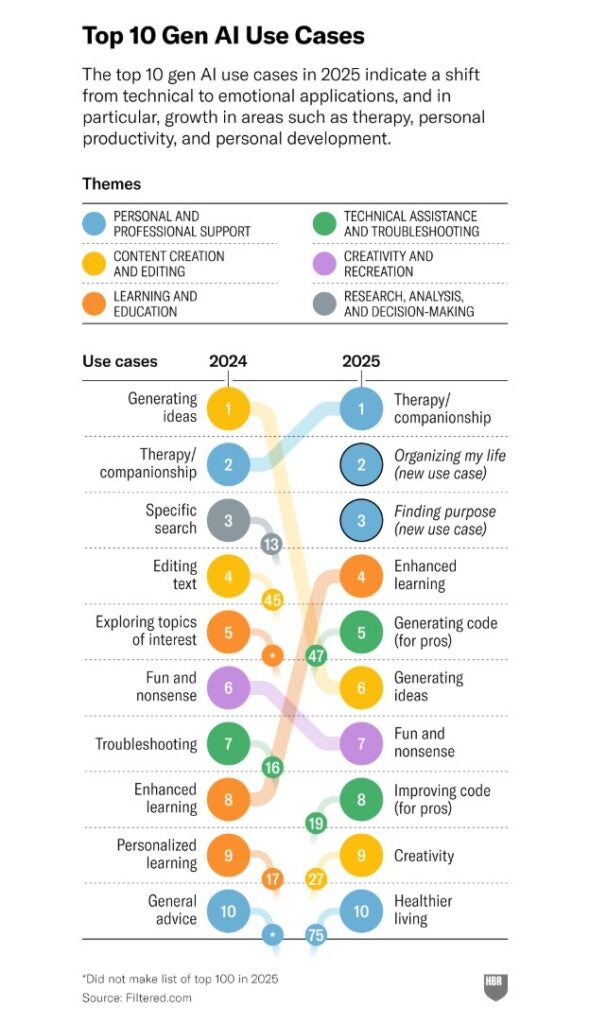
Top 10 GenAI Use Cases
Harvard Business Review
In 2023, Mustafa Suleyman (now CEO of AI at Microsoft) and Michael Bhaskar (AI strategy and communications at Microsoft) suggested a more quantitative test: give an AI $100,000, let it invest, and turn that sum into $1,000,000. Such a task involves complex reasoning, analytics, and forecasting.
We’re not there yet.
So which is it? It matters, because Microsoft and OpenAI are furiously negotiating over whether the latter’s models can be more broadly available, whether OpenAI can go public, and how much Microsoft’s stake in the company will be.
How Do We Measure AI and AGI?
To know if we’ve achieved AGI, we have to be able to measure it.
Several organizations have proposed tests. Lab42, headquartered in Davos, Switzerland, offers a battery of reasoning tests to measure just how “intelligent” an AI can be. Here’s a sample problem from their website:

Google’s DeepMind approaches the problem differently. It suggests a 2×2 matrix classifying “Levels of AGI,” in effect describing an AI as either narrow (can only handle certain types of problems) vs general (can handle a wide range of problems) on the one axis; and performance, that is, the extent to which an AI can mimic humans, on the other. A Level-0 application could be (for example) a calculator, with no AI; Level-5, somewhat terrifyingly, is termed “superhuman,” exceeding human capabilities. (Luckily, we haven’t achieved that yet.)
And there are lots of other possibilities. We could simply give it IQ tests, or current events tests, or empathy-emulation tests, or all of these and more.
Ultimately, I suspect, it will come down to a value judgment based partly on how well a given AI performs on quantitative tests – and how human it “feels.”
Which will make that pesky clause in the Microsoft-OpenAI contract difficult to resolve.
Efficiency and Innovation
Today, organizations spend large sums of money on fundamentally two types of initiatives: innovation and operational efficiency. (It’s true when you think about it.)
Every AI use case I’ve seen is about operational efficiency. AI can make your employees better writers, better coders, in general more productive – in many cases much more productive (full disclosure: I used AI to research this article – but not to write it.)
I’ve yet to see an AI that’s truly innovative. It’s difficult to imagine that AI could, independent of any human assistance, come up with a revolutionary product like the iPhone, for example. Sure, it could make an existing product better, improve production times, and so on – but true innovation?
To me that’s true “intelligence” and that’s our job, and always will be.
Progress, Determinism and Probability
Lastly: many have commented that our march to AGI has slowed, that progress in AI has plateaued. True, training and inferencing have become more efficient (see previous paragraph): Nvidia’s chips have gotten faster and denser, data centers are springing up everywhere (remember, capex=strategy) And OpenAI and others are testing new techniques like reinforcement post-training fine-tuning (basically you tell the LLM the right answer and it adjusts its weights accordingly).
Thus with continuing incremental improvements and the economics of scale, on the whole things arguably will gradually get better and perhaps cheaper (we’ll see).
But let’s remember: LLMs today are fundamentally probabilistic: they use advanced statistical algorithms to infer what the next best word or next best sentence in a response to a prompt might be. (Is post-training RL “cheating?” You be the judge.) That’s very different from how traditional, deterministic software applications work, in which you are guaranteed the same output for the same input.
In my opinion, what’s missing in current LLMs is a solid grounding in common-sense knowledge. “A dog is a mammal” – everybody instinctively knows that. Not an LLM, though – it reasons over its training base to determine that statement’s probability. It’s usually going to get it right – but it’s not guaranteed.
Therefore I suspect that the next major leap in AI will occur when LLMs can refer to a systematized ontology of indisputable facts to reduce probabilistic errors and hallucinations.
Net: it may be a while before an AI can truly pass as human.
Microsoft and OpenAI
Let us know!
Yes, we’ve digressed (but wasn’t it fun?). As I write this, Microsoft and OpenAI are trying to resolve their differences – who will win? Does it matter? What do you think?
I’m at bbriggs@directionsonmicrosoft.com.

Microsoft is increasing its campaign to give Windows 10 customers a safe exit strategy before it cuts off support (and specifically security updates) for that OS version in October 2025. Microsoft is doing this in two ways: By trying to get more individuals to sign up for Windows 10 Extended Security Updates (ESUs) and by going public with more details of how it plans to make Windows 11 more secure — and hopefully more compelling.
With less than four months to go before the end of Windows 10 support on Oct. 14, 2025, Windows 11 adoption remains lackluster. Most independent estimates claim as many as half or more of all Windows PCs are still on Windows 10. Some of these users just don’t like Windows 11; others cannot install it because their older PCs do not meet the hardware requirements. And unsupported Windows 10 PCs will make the overall Windows ecosystem less secure by making endpoints vulnerable to attacks.
Individuals Get More Windows 10 ESU Options
Earlier this week, Microsoft announced it would give users a couple of additional ways to get one year of extended support for Windows 10, enabling them to keep getting important security updates beyond Oct. 2025.
Enterprises already can enroll in the Windows 10 ESU program via a Microsoft Volume Licensing program. They also will get the option to purchase ESUs from Cloud Service Providers starting Sept. 1.
As previously announced, Microsoft is charging commercial customers USD $61 per device for Windows 10 ESUs for the first year, with the price doubling in Years 2 and 3. Microsoft is charging educational institutions USD$1 per device for Windows 10 ESUs for Year 1, with the price doubling in Years 2 and 3. The only way Windows 10 commercial customers can get Windows 10 ESUs for no additional charge for three years beyond the Oct. 2025 cut-off is to subscribe to Windows 365 and use it from a Windows 10 device locally or run a Windows 10 instance in an Azure Virtual Desktop.
Individuals/consumers running Windows 10 have a couple of new options to get ESUs. In addition to the already announced $30 USD single-year ESU option, Microsoft will allow individuals to redeem 1,000 Microsoft Rewards points to pay for the one-year ESU for Windows 10 or use Windows Backup to sync their settings to the cloud and get the one-year ESU for free. Starting in July, customers will see these new ESU options via an enrollment wizard that will be available via notifications and in Settings on their personal Windows 10 PCs.
Microsoft announced in May that it was extending the period during which it would provide security updates for Microsoft 365 apps running on personal and commercial Windows 10 PCs through Oct. 10, 2028. They also will get feature updates for Microsoft 365 apps through August 2026, Microsoft officials said.
Making Windows 11 More Resilient
Microsoft also provided more specifics this week around its Windows Resiliency Initiative, which it announced last year. One of the biggest changes, which Microsoft will begin testing in private preview among select security vendors in July, is moving antivirus and endpoint detection and response (EDR) apps out of the Windows kernel. Microsoft has been working with a variety of security vendors to head off update meltdowns like the one from CrowdStrike that hit millions of Windows machines worldwide last year. It’s not clear when these changes will make their way to Windows 11 customers
Microsoft also is planning to make available later this summer a new Quick Machine Recovery feature that is meant to help organizations quickly restore machines that cannot boot. Microsoft said the QMR feature will be generally available to all Windows 11 24H2 devices starting this summer. And as part of that summer update, Microsoft also will be replacing the Blue Screen of Death with a new Black Screen of Death that will provide clearer information on the screen about issues requiring reboots.
In addition, Microsoft is rolling out “in the coming weeks” a feature called Connected Cache that is meant to help organizations improve bandwidth when upgrading to Windows 11, handling Windows Autopilot device provisioning, performing Intune application installations and incorporating Autopatch monthly updates.
Microsoft also announced recently plans to clean up legacy drivers that Windows Update pushes to users’ devices when installing updates. Microsoft is making the change to reduce security and compatibility risks, officials said.
Related Resources
More Options for Windows 10 ESUs
How to Enable Extended Security Updates for Windows 10
Update on the Windows Resiliency Initiative
Windows Resiliency Initiative Will Affect Windows and Anti-Malware (Directions members only)

Microsoft is adding a new Sovereign Private Cloud option to its set of cloud services available in Europe. It also is expanding its existing Cloud for Sovereignty service with new features for European customers and renaming that service to “Sovereign Public Cloud.”
Microsoft announced its new Sovereign cloud strategy for European customers on June 16. Earlier this month, rival AWS announced plans to launch later in 2025 a new European Sovereign Cloud company, designed to be locally controlled in the European Union, staffed by EU citizens and subject to EU laws. Last month, Google updated its own sovereign cloud services and added a disconnected, air-gapped option for customers with strict data security requirements, as well as a new Google Cloud Dedicated option for local and regional partner deployments.
Calls for European countries and customers to reduce their reliance on the biggest U.S. cloud providers due to fears of political and trade havoc have definitely hit a nerve with Microsoft and other leading cloud companies. Microsoft’s new sovereignty announcements come on the heels of it announcing five new digital commitments meant to reassure European customers that Microsoft has their back, in spite of the chaos caused by the current U.S. government regime with tariffs, regulation, threats over data access and more.
Expanding the Public Sovereign Cloud Footprint
Up until now, Microsoft’s Sovereign cloud offering, launched in 2022, initially was built to host Microsoft 365, Dynamics 365 and Azure. Microsoft positioned it as an offering for highly regulated customers and government agencies throughout the world in select markets worldwide. At the time, Microsoft defined “sovereignty” fairly loosely; It was a term describing where data resided, but also applied to security, compliance, and policy requirements that were particular to various countries’ governments.
The Sovereign Public Cloud, currently in preview, is slated to be generally available in all European Azure regions in 2025. Sovereign Public Cloud is getting a new Data Guardian feature meant to ensure EU customers’ data is stored and processed exclusively in Europe and controlled exclusively by Microsoft employees based in Europe. The Sovereign Public Cloud also is now supporting customers and/or their partners who want to control the key management for the encryption of their data. Additionally, the Sovereign Public Cloud is getting a new service for administering the sovereignty functions called Regulated Environment Management.
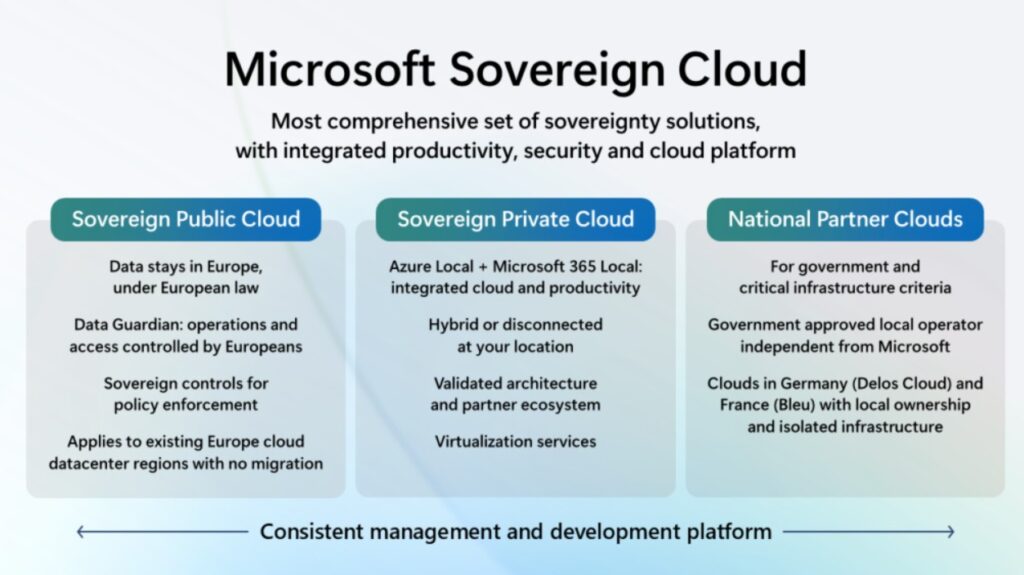
“Sovereign Public Cloud ensures customer data stays in Europe, under European Law, with operations and access controlled by European personnel, and encryption is under full control of customers. This is enabled for all customer workloads running in our European datacenter regions requiring no migration,” Microsoft officials said.
Sovereign Private Cloud features Azure Local, Microsoft 365 Local
Microsoft’s new Sovereign Private Cloud offering is for those who want to run their apps either on site, in partner datacenters or elsewhere in their own country. Microsoft says it will support hybrid or air-gapped (isolated) operations, and is built on top of Azure Local, the product formerly known as Azure Stack HCI.
The Private Cloud option also supports “Microsoft 365 Local,” which brings Office server software like Exchange Server and SharePoint Server to Azure Local running in a customer’s own datacenters or sovereign cloud environments. Microsoft says Private Sovereign Cloud is for governments, critical industries and regulated sectors needing the highest standards of data residency, operational autonomy and disconnected access.
As part of its June 16 announcements, Microsoft also gave the existing set of Sovereign Cloud offerings run by select partners a new name. These are now called “National Partner Clouds.” Partners working with Microsoft on these clouds include Accenture, Crayon, Capgemini, Dell Technologies, IBM, NTT Data, Orange, Telefonica, Vodafone and more.
Directions on Microsoft asked Microsoft whether it plans to make these new Sovereign Public Cloud features and the new Private Sovereign Cloud offering available beyond the EU. We asked for any pricing and licensing details that the company can share. We also asked if Microsoft planned to make Microsoft 365 Local available outside of its Private Sovereign Cloud service. So far, no word back on any of these questions.
Update (June 17): A Microsoft spokesperson replied with answers to all three of our questions.
Regarding pricing and licensing information: “Microsoft’s Sovereign Public Cloud and Sovereign Private Cloud solutions are currently in preview and set to be generally available in all European cloud regions later this year. We will share more details on costs, if applicable, as offerings become available.”
Regarding making the updated Sovereign Cloud offerings available beyond Europe: “We are starting with 15 EU/EFTA countries and will add additional countries and regions, aligned to customers’ needs.”
Regarding making Microsoft 365 Local available outside of the Sovereign Private Cloud: “Microsoft 365 Local is a deployment and management framework that enables customers to run Microsoft productivity workloads like Exchange Server and SharePoint Server on Azure Local infrastructure. We are not announcing licensing changes for those products as part of this approach.”

Microsoft is warning Microsoft 365 enterprise customers of some changes coming in July 2025 that could affect how and how often organizations will get Office app updates on Windows desktops. Organizations that have been juggling updates via the Semi-Annual Enterprise Channel in a way that allowed them to only update their apps once a year are going to be forced to update twice annually, thanks to the coming new policies.
Microsoft published information on pending update changes to the Microsoft 365 Message Center (MC1087098) on June 2. Administrators need to take action quickly to ensure desktops continue to get regular feature and security updates.
Microsoft officials said they are making the changes in order to “streamline updates and align with customer needs.” In other words: We are rolling out new features, especially AI/agentic ones, at a fast clip and we want customers to get access (and pay us, if possible) as soon as possible.
Currently, Microsoft offers three primary update channels for M365 Enterprise App customers: The Current Channel; Monthly Enterprise Channel; Semi-Annual Enterprise Channel. (It also has a Semi-Annual Enterprise Preview Channel and Semi-Annual Enterprise Extended Channel.) Microsoft uses these channels to provide both feature updates and security and non-security updates for Microsoft 365 desktop apps.
Up until now, those who opt for Current Channel get new Microsoft 365 Apps features as soon as they’re ready, which means typically at least once a month. Monthly Enterprise channel gets new or updated app features on the second Tuesday each month. Those in the Semi-Annual Enterprise Channel also get feature updates on the second Tuesday, but only in January and July. Semi-Annual Channel Preview is for customers who want to preview new features coming to the Semi-Annual Channel ahead of deploying them. The Semi-Annual Extended Channel is for updates delivered to subsequent releases of previous forks.
What’s Happening When
Beginning in July 8, 2025, Microsoft will no longer provide updates via the Semi-Annual Enterprise Channel Preview. Officials said organizations should move devices on this channel to another supported channel if they want to keep getting early access to new features and security updates. And as of March 10, 2026, it is dropping support for Semi-Annual Enterprise Channel Extended.
Microsoft is making other channel changes starting in July 2025. The Monthly Enterprise Channel will get rollback support for two months, up from one. The Semi-Annual Enterprise Channel will be supported for fewer months — from 14 months to 8 months. (The eight months includes 6 months of regular support plus the 2-month rollback period.)
The Semi-Annual Enterprise Channel will be meant for unattended devices, going forward, according to Microsoft. (Up until now, Semi-Annual Enterprise Channel was for “non-interactive devices and those running specialized or business critical workloads that require extensive testing” before new features are implemented.)
“Bottom line: You have to deploy new Office versions twice a year if you are on the Semi-Annual Enterprise channel – up from once,” said Directions on Microsoft analyst Rob Helm.
Currently, via the Semi-Annual channel, Microsoft supports new Office app releases for 14 months. That means that enterprises can deploy new versions of Microsoft 365 Enterprise apps in January, ignore the July updates and then deploy the newest versions the following January. The supported roll-back window meant if there were any issues with the new Office apps, companies could revert to a version that was more than a year old until the problems were fixed or a newer version of the apps was available.
Organizations can change the Microsoft 365 Apps update channel for their devices using Group Policy, the Office Deployment Tool (ODT), Configuration Manager, Intune Administrative Templates, and/or the Microsoft 365 Apps Admin Center.
Related Resources
Microsoft 365: Retiring and modernizing the Semi-Annual Enterprise Channel for Windows desktop apps
Updates Coming to Microsoft 365 Apps Channels
From 2020: Microsoft starts pushing enterprise to pick up the Office app update pace
How to change Office update channels

Microsoft has once again “clarified” rules that change how Dynamics 365 user license compliance is measured but could also simplify how to determine what user licenses are required. Many Dynamics 365 Finance + Operations customers should spend time now cleaning up security roles assigned to their users, before Microsoft potentially claims they are out of compliance. (Note: this change does not impact Dynamics 365 CRM customers.)
What Happened?
On May 3rd, 2025, I was going through the latest Dynamics 365 Licensing Guide to look for changes, when I noticed the addition of a sentence in Appendix E on page 56:
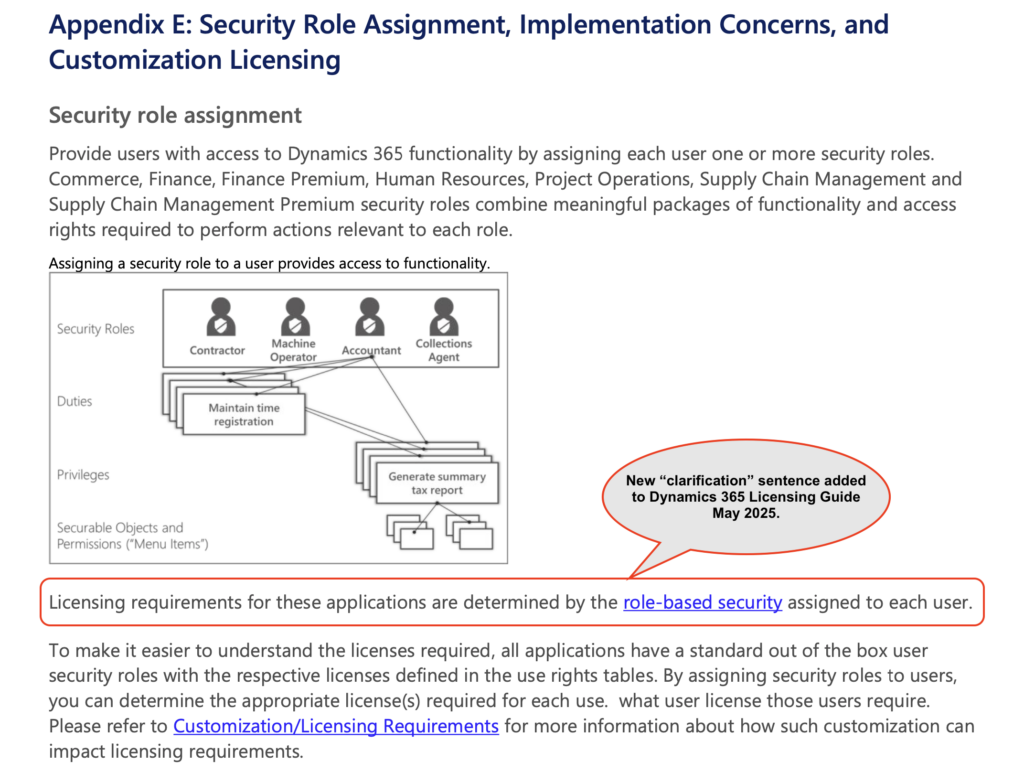
“Licensing requirements for these applications are determined by the role-based security assigned to each user.”
“These applications” refers to the Dynamics 365 Finance and Operations applications: Finance, Supply Chain Management, Commerce, Project Operations, and Human Resources.
The significance of the sentence is that the user licensing requirements for Dynamics 365 Finance and Operations applications have shifted from “what a user actually did” to “what a user could potentially do.”
Previously, organizations were on the hook for a Dynamics 365 license based on the application users accessed, the routines they ran, and the type of data they updated. Microsoft provided some reports that gave guidance on what license users “might” require, but the ultimate test of license compliance was based on activities users performed. This could only be determined by viewing audit logs, which had their own limitations, or by evaluating the custom screens or custom applications users accessed, because these custom screens and applications programmatically limited what users could do. (In Nov. 2024, I wrote extensively about how to tackle user license compliance for our members in “Dynamics 365 User License Compliance: A Struggle that Benefits Microsoft.”)
However—and this is a big however—going forward, the new sentence “clarifies” that what a user actually does is no longer relevant, because organizations are now on the hook for a Dynamics 365 license or licenses that cover security roles assigned to users.
Why is this a Concern?
I’m concerned for companies who have enjoyed Microsoft’s relaxed approach to user license compliance and have routinely handed out higher security roles than needed, which now exposes the organization to new (sorry, “clarified”) license requirements.
The licensing change won’t severely impact everyone, especially not those customers who were diligent with assigning security roles, but I do think it will be a problem in the following scenarios:
Security roles applied for convenience. Many admins took the easy approach and assigned users with as many security roles as needed to get the user working and meeting any potential request, reducing the need for the user to come back and ask for more rights later. Is this a best practice? No. But we all know that it happens.
Customizations using default security roles. This is the biggest issue. Most customers customize Dynamics 365 Finance + Operations in some way. They modify Dynamics 365 screens to remove certain fields or add access to other data, and some customers build or purchase custom applications that augment the Dynamics 365 service and access data directly. In these situations, an admin must still assign users with a security role, and those security roles (especially the default ones) often contain rights beyond what a user needs for the custom scenario. This is generally acceptable, because the custom screen or application limits what a user can do, so giving them excessive rights is a low risk.
However, with the new sentence in the Licensing Guide, all users are required to have a license based on the security roles they are assigned, whether or not they actually perform activities allowed by those security roles.
What Should Customers Do?
Don’t panic. Although the change is in place as of May 2025, there is no automatic compliance check that will lock users out if they don’t have the right licensed assigned. What you should do is start planning for your next audit or renewal, so I recommend the following steps.
- Talk with your Dynamics 365 security admins and find out how big of an issue this is. They will have the best sense of the magnitude and risk for your organization.
- Adopt a “least access” approach to security roles. In other words, do the right thing and only assign users the security roles and features they need, rather than being overly generous. In many cases, this will involve building custom security roles that only grant rights to the features and data users actually need. Custom security roles are a common approach and nothing to be feared.
- Clean up existing security role assignments. Microsoft is previewing new license compliance reports that compare the security roles a user has (and therefore the license required) with the licenses users are assigned. The reports can highlight when users are under licensed, but I suggest using it as a starting point to determine if users have excessive security roles or could benefit from a custom security role that has a lower licensing requirement.
- Talk with developers who customize the Dynamics 365 service and determine if they used default security roles or custom security roles to provide access to their custom solution. Typically, custom solutions benefit from custom security roles that grants the least number of rights and therefore the lowest possible license requirement.
Do you really read the Licensing Guide each Month?
It’s been asked this many times and yes, I read through the new Licensing Guide every month, looking for changes that impact customers.
I also keep a copy of most of them, in case I need to look back through time. I’m not sure anyone needs a “Dynamics 365 (On-premises) Enterprise Edition – Dec. 2016” licensing guide, but I have one.
In a similar situation, last April, I wrote about how Microsoft “clarified” licensing rules about Dynamics 365 and Power Apps last April as well in “Dynamics 365 rights in Power Apps Subscriptions: Changes on the horizon.”
Related Resources
Directions kit “Dynamics 365.” (Directions members only)
Licensing Reference Set for Dynamics 365 (Directions members only)
Microsoft has announced the planned retirement of SharePoint Alerts for SharePoint Online by July 2026. SharePoint Alerts have been around since the dawn of time so if you have used SharePoint for a while in your organization, there’s a good chance you and your users will be affected as early as September 2025.
If your organization is new to SharePoint, don’t get started now with Alerts. Evaluate using SharePoint Rules or Power Automate which are now the preferred methods of sending alerts (aka notifications).
SharePoint Alerts are email or text notifications users can set up to track activity in the SharePoint sites they use. Alerts apply to lists and document libraries and can be an extremely helpful tool when used wisely. When users configure an alert, they can select the type of change that will trigger them, such as when anything changes, when someone else changes an item, or when someone else changes an item created or modified by the user. To manage notification overload, users can also specify how often to receive alerts: immediately, daily or monthly. Since this is a user-managed tool, you can imagine how many of these alerts may exist in your environment.
SharePoint will turn 25 years old next year. There’s a lot of legacy technology in the platform and the alert mechanism is among them. It’s being replaced by a choice between SharePoint Rules and Power Automate, both using more modern technologies. That doesn’t mean there won’t be pain. Users are accustomed to the current alerts and must be prepared for the switch. It’ll be a new experience which means organizations will have to educate and train them on which approach will be used (or both) and how to adjust their ways of working.
What’s Microsoft’s Plan (and Yours)?
While Microsoft announced the end of SharePoint Alerts will be July 2026, it will begin turning off new alert creation as early as July 2025 for customers new to SharePoint. Existing customers may start seeing new alert creation turned off starting in September of 2025.
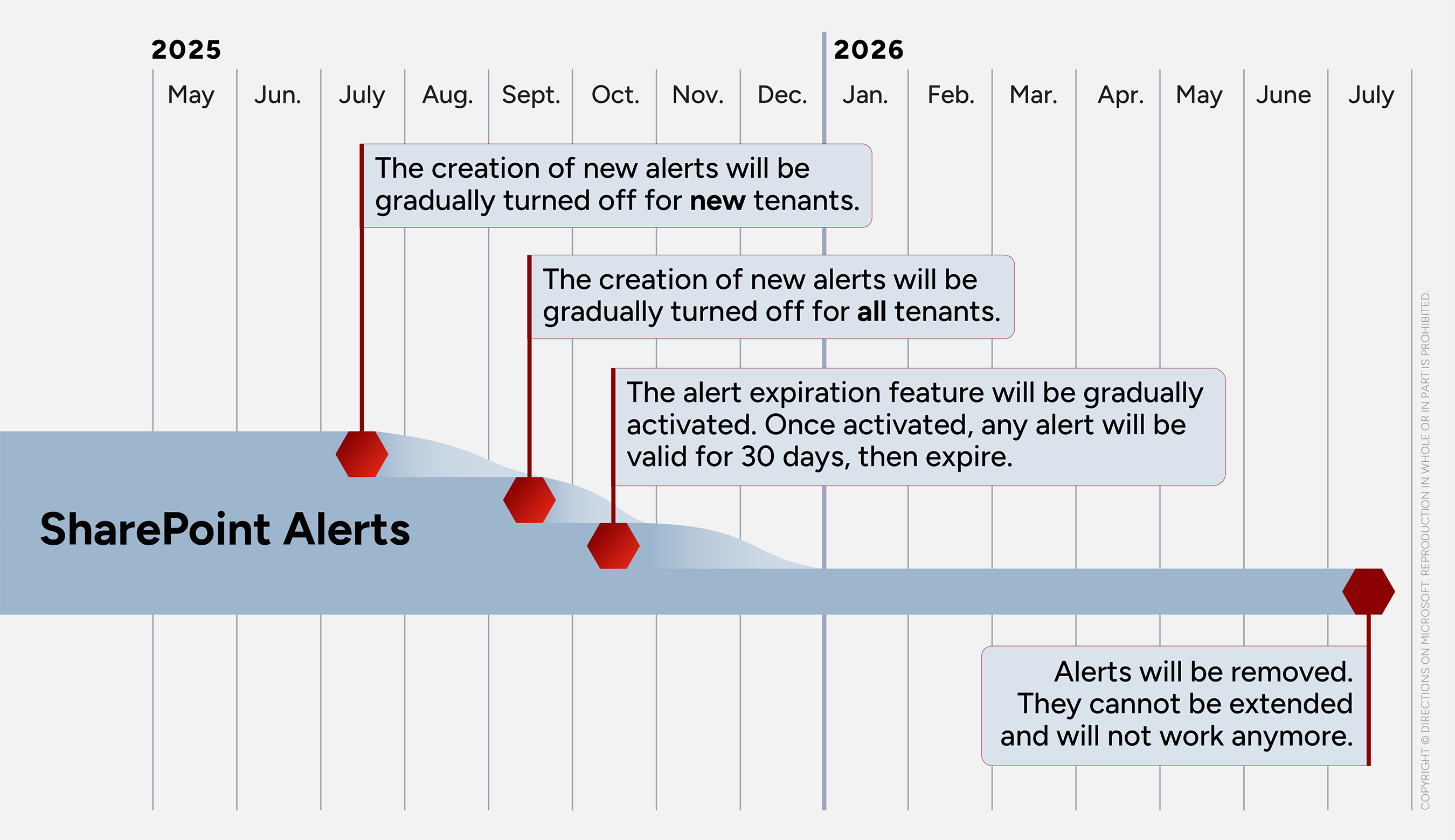
Start planning for the transition and exploring the modern approaches of SharePoint Rules and Power Automate. To help with planning, you can use the Microsoft 365 Assessment tool to identify Alert usage and begin to understand the size of the task at hand. Users will begin seeing warning banners on various configuration pages in SharePoint so it’s important that you have a plan to communicate it out to your organization before panic ensues.
Evaluate your options between SharePoint Rules and Power Automate. You will have to determine when to use what and educate your users on the approach(es). SharePoint Rules are native to SharePoint, but Power Automate is licensed and may incur additional costs.
Communicate your plan to your users. And communicate it again.
The Wrap Up
At this time, there is no indication from Microsoft of a migration approach from alerts to either SharePoint Rules or Power Automate. This also only appears to apply to SharePoint Online for now. However, since Microsoft removes other legacy technology from SharePoint Server, it may be coming to you in the future.
Is this important to you? Let me know what else you want to hear about by emailing me at dberry@directionsonmicrosoft.com.
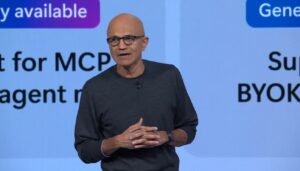
Microsoft’s annual Build developer conference is happening this week in Seattle. No big surprise: All things AI and, specifically, agents, are at the top of the announcement list. Surprise: There was quite a bit of news for those still developing on Windows, too.
In no particular order, here are my top 10 takeaways from Day One of Build:
1. Multi-agent is the new hot. Organizations will soon be able to build multi-agent systems in Copilot Studio, where agents delegate tasks to one another. The agents can be built with the Microsoft 365 Agent Builder, Azure AI Agents Service, and Azure Fabric. The Copilot Studio capability to build multi-agent systems is now in preview.
2. NLWeb is a way to turn websites into agentic apps. Natural Language Web (NLWeb) is a Microsoft-developed project for simplifying the natural language interface for websites. (It’s not clear what, if any, connection that OpenAI has with NLWeb. Other current sponsors of NLWeb include O’Reilly Media, Snowflake, Shopify, Chicago Public Library.) Microsoft says NLWeb was conceived and developed by R.V. Guha, former Google Tech Fellow who recently became a Microsoft CVP and Tech Fellow. Guha is the creator of RSS, RDF and Schema.org.
3. GitHub Copilot is moving from pair programmer to peer programmer. GitHub Coding Agent (“Project Padawan”) is now generally available to all Copilot Enterprise and Copilot Pro+ customers. The agent is best suited to low-to-medium complexity tasks in well-tested codebases and can handle things like adding features and fixing bugs to extending tests, refactoring code, and improving documentation, Microsoft says.
4. Copilot Studio is getting more and more “pro” dev features. As was evident at Ignite last fall, Microsoft increasingly is positioning Copilot Studio, its low-code/no-code development platform, as a tool for professional developers who need more powerful tools to build more complex agents. Microsoft is working on exposing a set of M365 Copilot APIs for developers. (So far, only the retrieval API is available in preview.) Microsoft is working to close the gap between Foundry and Copilot Studio by enabling a Bring Your Own Models from Azure Foundry capability, which is currently in preview.
5. The MCP protocol is becoming increasingly key to building agents. Microsoft has joined the Model Context Protocol (MCP) Steering Committee is integrating MCP support across GitHub, Copilot Studio, Dynamics 365, Azure, Azure AI Foundry, Semantic Kernel, Foundry Agents and Windows 11. “Think of MCP as a universal USB-C connector for AI,” linking apps, agents and tooling in a standardized way.
Windows: The Best AI Dev Platform?
6. The Windows 11 Copilot Runtime has been renamed “Windows AI Foundry.” AI Foundry is now Microsoft’s brand for the local-platform versions of Azure AI Foundry and are built for model selection, optimizing, fine-tuning and deployment across client and cloud. Microsoft officials say that Windows ML is the built-in inferencing runtime on Windows. Microsoft also announced a local version of AI Foundry for the Mac. Both of these local Foundry offerings are generally available.
7. Microsoft is open sourcing the Windows Subsystem for Linux (WSL). They’ve already open sourced the “Mariner” Linux underpinning and the WSL-g UI layer. Now it also is open-sourcing most of WSL itself for “reasons.” Maybe the community will do something with direct access to WSL APIs? Microsoft also announced plans to open source the GitHub Copilot Chat Extension for VSCode “in the coming weeks.”
8. Microsoft is expanding Entra, Defender for Cloud and Purview by embedding them directly into Azure AI Foundry and Copilot Studio to help organizations secure AI apps and agents across the entire development lifecycle. Entra Agent ID, a capability meant to manage built using Microsoft tools, as well as across select third parties like ServiceNow and Workday, is now in preview.
9. SQL Server 2025 is now in public preview. The coming release of SQL Server is now available to testers. Microsoft is touting the integration of AI directly into the database engine “enabling more intelligent search.” It also has built-in vector search capabilities.
10. OpenAI CEO Sam Altman and Special Government Employee and xAI Founder Elon Musk both appeared in Nadella’s keynote — via video. Musk talked up Microsoft hosting Grok 3 and Grok 3 Mini in Azure Foundry (like it already does with thousands of third-party models, including DeepSeek). Altman talked about OpenAI’s announcement of its Codex programming assistant (while making sure to show continued excitement about the great Microsoft partnership OpenAI enjoys).
To read about all of the Microsoft Build 2025 announcements, check out the Book of News. Fun Fact: There are more than 300 mentions of “agent” in Microsoft’s Build news. And around 30 mentions of “Copilot.” It’s hard to keep up, especially when it comes to AI branding at Microsoft….

Microsoft has announced it will provide security updates for Microsoft 365 apps running on Windows 10 until Oct. 2028, rather than until Oct. 2025, as planned.
The company published an article on Microsoft Learn announcing the change on May 8, 2025. (Thanks to Neowin for the original link.)
Microsoft 365 apps would have continued to work on Windows 10 after Microsoft support ends for the operating system on Oct. 14, 2025, the company acknowledged, but they would have run unsupported. To try to deter customers from running these apps on Windows 10 after support ends, Microsoft officials have said running these apps on an unsupported OS could potentially cause “performance and reliability issues.”
Microsoft is now planning to provide security updates to the Microsoft 365 Apps on Windows 10 until Oct. 10, 2028 “to help maintain security while you transition to Windows 11,” the Learn article notes. The new security update also applies to the subscription versions of the Project and Visio desktop apps, official said.
The new security update extension does little, if anything, regarding Microsoft-provided support for M365 apps running Windows 10 after Oct. 14, 2025, the Microsoft Learn article says.
If a customer with a valid Microsoft 365 subscription has issues with their apps, they will continue to be able to open support cases, but Microsoft support will provide only troubleshooting assistance. “Technical workarounds might be limited or unavailable,” the article says. Whether or not customers on Windows 10 have ESUs, they do not have the option to log a Microsoft 365 apps bug or request other product updates.
Will Windows 10 Get a Security Reprieve, Too?
Directions on Microsoft has asked Microsoft if there will be a similar three-year pushback on the date when security updates will no longer be provided for Windows 10. No word back so far.
Update (May 13): A Microsoft spokesperson declined to answer the question we posed and instead provided a link to an April 2024 Microsoft blog post on when to use Windows 10 ESUs.
We’d point out that Microsoft provided an additional three years of security updates for Microsoft 365 apps on Windows 7 when Windows 7 was approaching its end-of-support date.
Given that Microsoft has announced it will be selling Windows 10 Extended Security Updates (ESUs) for three years and to consumers for one year, we’re thinking a delay on the end of support for Windows 10 seems unlikely. Microsoft is charging commercial customers USD $61 per device for Windows 10 ESUs for the first year, with the price doubling Years 2 and 3.
However, if there are a substantial number of Windows 10 business and personal PCs still running after Oct. 10 this year, the security risk caused by these systems will be substantial. Various market watchers have estimated that fewer than 50 percent of Windows PCs are running Windows 11. Microsoft is continuing to advise customers to move off Windows 10, either by upgrading to Windows 11 on eligible PCs, licensing Windows 365, or by buying new PCs that support Windows 11.
Related Resources
Windows 10 end of support and Microsoft 365 Apps
Meteor 2025: The Next Wave of Windows and Office Migrations (Directions members only)
Directions Licensing Reference: Extended Security Updates for Windows 10 (Directions members only)
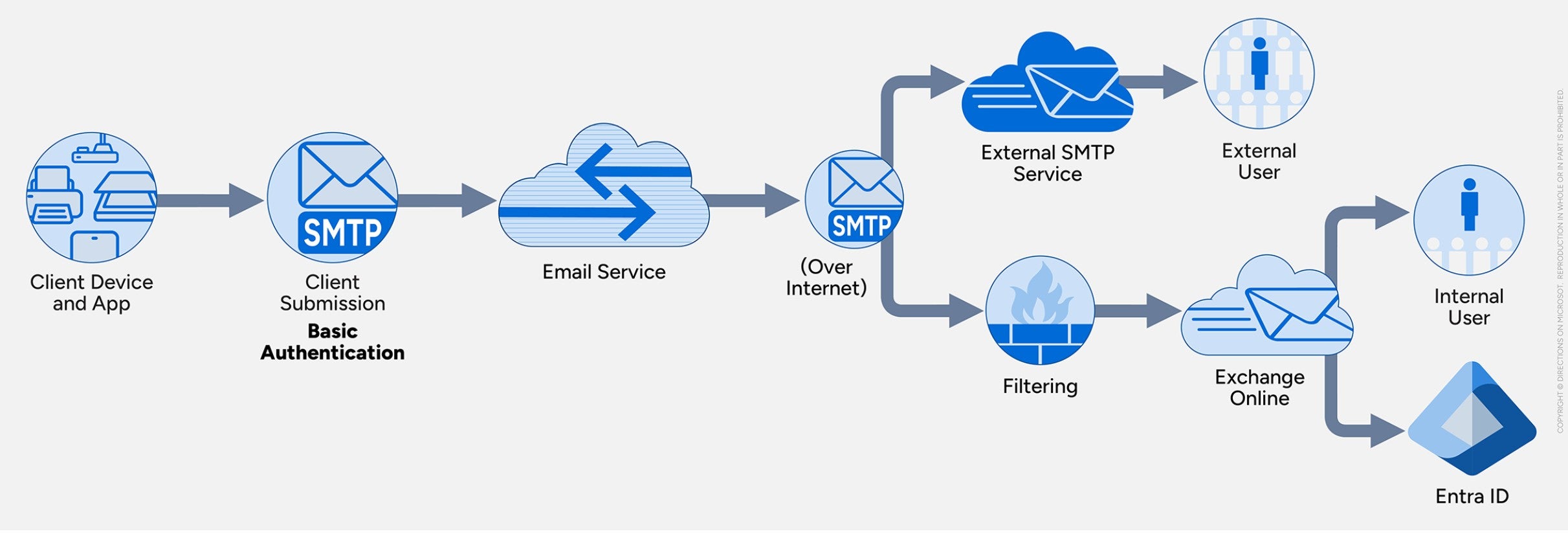
Exchange Online will block Basic Authentication for SMTP client submission beginning in Sept. 2025, cutting off some devices and applications unless customers take action. At potential risk are devices such as mail-enabled document scanners and multifunction printers offering “scan to mail.” Applications that send e-mail alerts to groups of individuals, such as CRM applications notifying salespeople of a particular change, also could be impacted.
But never fear: Microsoft is here to save you from your security insecurities – for extra fees, of course.
Microsoft announced the Sept. 2025 Basic Authentication shutdown date last April, citing security risks as the cause. Microsoft gradually has been removing support for Basic Authentication and warning developers against it for years, saying the protocol is too vulnerable to brute force attacks.
Time to Go ‘Modern’?
Customers have several options to prevent mail cutoffs caused by the end of Basic Authentication. Generally, all users should be working to update e-mail senders to use “Modern Authentication,” while building interim solutions to deal with Basic Authentication senders still in use.
Modern Authentication is Microsoft’s name for a set of more secure authentication protocols based on the OAuth 2.0 protocol. With an upgrade to Modern Authentication, a device or app can send mail through Exchange Online to internal and external recipients with minimal other changes.
Many older devices and applications don’t work with Modern Authentication and cannot be upgraded. Conveniently, Microsoft does offer two e-mail services that accept SMTP client submission with Basic. However, both cost extra. (Got to keep those $20 billion USD-plus of Microsoft Security revenues coming in from somewhere)
Other Options (for a Fee)
The two ways Microsoft is offering to upsell you:
High Volume Email for Microsoft 365 (HVE). This paid add-on to Exchange Online, in preview, accepts SMTP client submissions with Basic Authentication. But HVE, which Microsoft has said will be generally available in Sept. 2025, can only deliver to internal recipients in Exchange Online. As announced earlier this month, Microsoft plans to permit Basic Authentication with HVE until Sept. 2028. Customers get three more years of using a less-secure authentication mechanism, as long as they are willing to pay. Win-win?
Azure Communication Services. This option offers video and voice calling over IP, SMS text, chat, and e-mail services that developers can build into applications. The e-mail services can accept SMTP client submission with Basic Authentication. Unlike HVE, Azure Communication Services can deliver to recipients inside and outside the customer organization, and the service already is generally available. But it doesn’t offer the same exact security, availability and privacy guarantees as Exchange Online.
Well-established third-party solutions such as Intuit Mailchimp and Twilio SendGrid are available, too, but they’ll also cost you extra.
“Microsoft deserves credit for campaigning against Basic Authentication all those years,” says Rob Helm, a Directions analyst. “I hate to see it slowing down just short of the goal to sell tickets.”
Related Resources
Microsoft to Block Basic Senders in Exchange Online in Sept. 2025 (Directions members only)
Microsoft Introduces Control for Direct Send in Exchange Online

While writing a report on Windows 365 Link earlier this year I realized my career has gone full circle. This realization struck me as a sign it was time to call it a day.
Everything Old is New Again
How is it my career has gone full circle? Well, it started when I graduated from university fifty years ago this year with an undergraduate degree in Biology. I couldn’t find work in biology. My first paying job out of college was working as a contractor in a community outside Edmonton, Alberta installing up-to four new RJ-11 jacks per house. Prior to that, most phones in residences were hardwired. I was paid by the jack, so I ensured each house got their four jacks, even if the fourth one was in the basement and totally unusable because it was in the first-floor joists next to the lightening arrestor where the phone line entered the house. From there I moved on to working for a company that took off-air signals from the CBS, NBC, and PBS stations in Spokane Washington from an antenna site on Mt. Kelly in British Columbia (Google Maps) and microwaved them across the Rockies so subscribers in Calgary and Edmonton could view them. For a fee. This was when CATV stood for Community Antenna, and it is also where my curiosity for networking began. Eventually I became responsible for making the billing system for the cable company work on a minicomputer running software from a company called CableData. Although I played around with early PCs including a Timex PC that hooked up to channel 3 on a TV working on the Control Data hardware and CableData software combined my curiosity about networking with a new curiosity about computers and software.

From there I moved onto working for Alberta Government Public Works, Supply and Services in the Terrace Data Center in Edmonton. There my job was to help keep IBM 327x terminals (Fig 1.), control units, and 370X front-end processors connected.
Fundamentally, these devices created a network where dumb terminals, which did minimal local processing, relied on the compute power in IBM mainframe computers. So, how did I get from here, working on mainframe networks to working on PC networking?

Well, it was about this time that IBM and IBM compatible computers started to enter businesses, mostly for spreadsheets. As was common on these early PCs, companies made add-in cards that could be inserted into the PC to provide specialized services, such as advanced memory management, local area network connections, and one in particular—called an IRMA card—that I was curious about because it claimed to allow the PC to emulate a 327X terminal by connecting to a controller (Fig 2). Actually, it was more than a claim, it really worked very well. We could now use PCs with IRMA cards in place of 327X terminals and the user could use PC apps and access the mainframe.
Although it runs a version of the Windows client OS, Windows 365 Link (Microsoft) completed the circle as it is dumbed down by software controls to be no smarter than a dumb 327X terminal.

It relies on the power of computers in a data center to do any heavy lifting compute wise. The circle is complete. My journey went from networking mainframes, mini-computers, and PCs and for all intents and purposes back to the mainframe again.
Be Curious
This struck me hard. It made me realize that I’d lost my curiosity for technology. And to be a good analyst you need to be curious. They say do something you like, something you’re passionate about. I think you’re better off doing something you’re curious about. And now I’m curious about the irises and wisterias in my garden. I’m curious about wood working. So that’s what I’m going to do now.
As I retire, I know I need to thank a lot of people for their support. This is a problem, because I know I will forget someone who was instrumental. If this is the case, I mean no slight, it is merely that I have always been bad with names.
Thanks Directions Subscribers
First, I want to thank Directions’ subscribers. I hope my analysis provided insights that saved you time and money. It was fascinating to learn about your businesses, and your technology requirements. And especially to learn how you exploit the potential of Microsoft’s products and services.
Thanks Directions’ Great People
I need to thank Paula and Marie, for editing my thoughts and ideas and making them understandable and readable. I’m sorry I never learned the rules for using em and en dashes and commas. I need to thank King Brian for taking my stick figures drawn in Visio and PowerPoint and converting them to charts and illustrations, so my reports were not just a wall of words.
Thanks Bev, Erika, Dean, Kim, Lauren, Marian, Mariia, Matt, Mona, Niki, Stephanie, and Will. You made sure I had everything I needed to do my job. But especially you ensured people could access my work and hopefully find some insights that were valuable.
Of course, I need to thank all the analysts at Directions—past and present—including Andrew, Anne Marie, Barry, Chris, Don, Greg, Jim, Josh, Mary Jo, Matt, Paul, Peter, Rob, Rob, Rob, Scott, Wes, et. al. I was humbled to work with such smart peers. And to Jeff and Rob for creating a company with few rules, a ton of intellectual freedom, time to research ideas, and where people could agree, discuss, debate, and even disagree (politely) about technology, strategy, and how to communicate meaningful information to people looking for real insights.
Just a Few More People That Really Helped
I know, they are starting to play the music to get me off stage, but there are just a few other people who work in the technology press, Microsoft, or other vendors who helped including Adrienne, Janell, Laura, Matt, Noury, Paul, Todd, and Woody. And to the managers at all the companies I worked at for realizing I had a modicum of talent and took a risk on me. I appreciate your confidence, and I thank you. I learned something I needed for the next stage of my career at each of the jobs along the way.
Figure 1 Attribution: Retro-Computing Society of Rhode Island, CC BY-SA 3.0, via Wikimedia Commons
Figure 2 Attribution: Konstantin Lanzet, GFDL, via Wikimedia Commons

Microsoft reported its Q3 FY25 earnings this week. Coming in at $70.1 billion USD in revenue for the quarter and earnings of $3.46 USD/share, the results exceeded expectations. Unsurprisingly, Microsoft execs gave most of the credit to the Microsoft Cloud and Azure, in particular.
Microsoft Cloud – the Microsoft-defined bucket of commercial cloud properties including Azure, M365 commercial, Dynamics 365, etc. — delivered $42.4 billion USD in revenue, up 20% from the year-ago quarter. Azure and other cloud services revenue were up 33%, with 16 points of that coming from AI, they said. (Microsoft still doesn’t disclose Azure revenues in dollars.) And for Q4 FY25, Microsoft is projecting Azure and other services growth will be between 34% and 35%.
Microsoft is still on track to spend $80 billion USD on building the datacenter/AI infrastructure during its fiscal 2025, which ends June 30. Microsoft opened datacenters in 10 countries across 4 continents this quarter alone. Last quarter, Microsoft officials had said they expected to be able to ease back on this spending starting in July, but because datacenter capacity demand is growing faster than it expected, “we now expect to have some AI capacity constraints beyond June,” CEO Satya Nadella said.
Microsoft 365 Commercial Now at 430 Million Paid Seats
In Jan. 2024, during its Q2 FY24 earnings call, Microsoft officials said the company had 400 million paid Microsoft 365/Office 365 seats. That figure is now 430 million paid commercial seats, up 7% year over year, as of this quarter, officials said. The growth is largely due to small/mid-size businesses and frontline workers. M365 consumer subscriptions are now at 87.7 million, in spite of Microsoft’s recent price increase.
Microsoft still is not providing publicly a Microsoft 365 Copilot adoption number. Officials said Microsoft 365 Copilot is being used by “hundreds of thousands of customers” and is up three times year-over-year. (It’s not clear whether this count includes the “free” Microsoft 365 Copilot Chat, but as officials didn’t mention these are “paid” seats, I’m guessing Microsoft 365 Copilot Chat is part of these totals.)
- A few other enterprise-focused datapoints Microsoft officials shared in the earnings call:
- There are 21,000-plus paid Fabric customers now, up 80% year over year. Real-time intelligence is the fastest growing workload in Fabric.
- The Microsoft Phi small language model has been downloaded 38 million times.
- There are now more than 15 million GitHub Copilot users, up more than four times year-over-year.
- There are now 56 million monthly active Power Platform users, up 27% year over year.
- Windows 11 commercial deployments are up 11% year over year. (Note: Most PC-tracking firms say Windows 11 is still on fewer than 50% of work and personal-use PCs.)
- Windows OEM and Devices revenue was up 3% year over year, which is ahead of expectations as tariffs imposed by the U.S. government led to uncertainty through the quarter.
Datacenter Slow-Down: Nothing to See Here, Microsoft Says
As expected, almost all of the Wall Street analyst questions at the end of the April 30 earnings call were focused on reports that Microsoft recently has been pulling back on planned AI/datacenter spending. Chief Financial Officer Amy Hood and Nadella claimed these reports are the result of analysts paying more attention than before to Microsoft’s CapEx spending patterns. (Hmm…) They maintained that Microsoft is making normal adjustments to datacenter build-out plans that were originally created years ago, based on current demand signals.
Hood emphasized that Microsoft’s CapEx plans are not entirely about AI. She told analysts that non-AI spending was higher than expected in Q3.
“The real outperformance in Azure this quarter was in our non-AI business. The only real upside we saw on the AI side of the business was that we were able to deliver supply early to a number of customers,” Hood said.
Watch for Microsoft’s Coming Sales Reorg
Separate from earnings, Microsoft announced internally a sweeping sales reorg late last week that will take effect July 1. The company looks to be trying to flatten the sales org and is moving a lot of the vertical businesses around into new operating units.
Microsoft’s current sales org is designed around six solutions areas: Modern work, Business Applications, Digital & App Innovation, Data & AI, Azure Infrastructure, and Security. The plan is to combine these into three areas: AI Business Solutions, Cloud & AI Platforms, and Security.
Microsoft is making a big push to build up technical expertise in the field and is requiring sales to meet certain AI skilling criteria over the next couple of months as part of its effort to “accelerate AI transformation.”
Microsoft Q3 FY25 Earnings Slides, Transcript
Microsoft explains new datacenter ‘pause’

Calls for European countries and customers to reduce their reliance on the biggest U.S. cloud providers seem to have hit a nerve in Redmond. On April 30, Microsoft announced five new digital commitments meant to reassure European customers that Microsoft has their back, in spite of the chaos caused by the current U.S. government regime with tariffs, regulation, threats over data access and more.
As enterprises know, it’s not a trivial matter to switch clouds or try to repatriate workloads and apps from the cloud back to on-premises. It’s one thing to talk about reducing dependencies on U.S. tech providers and build alternative European-owned/run “Eurostacks.” But it’s another to put these kinds of plans into action. Microsoft officials know how difficult and expensive it is for customers to untangle themselves from Microsoft’s cloud once they’ve bought in.
Whether Microsoft’s new commitments are more theatre or reality, these promises come with a number of questions.
Build out or scale back? Which is it?
On April 30, Microsoft pledged to increase its European datacenter capacity by 40% over the next two years and promised to expand datacenter operations in 16 European countries. This means Microsoft will “more than double our European datacenter capacity between 2023 and 2027,” and enable Microsoft to offer cloud services in more than 200 datacenters in Europe, according to Microsoft president Brad Smith.
Smith and other Microsoft officials didn’t provide a list of the countries or share details on the costs of the planned expansion. They also didn’t explain how this expansion will jibe with the company’s recent moves to slow its previously announced AI and datacenter buildouts worldwide. In spite of its pull backs, Microsoft has continued to promise it will spend $80 billion on its datacenter infrastructure in fiscal 2025 (which ends June 30, 2025) and somewhat less in fiscal 2026.
Smith also touted its partnership with smaller European cloud providers, via which Microsoft is enabling smaller hosting providers to deliver Microsoft apps and services on their local infrastructure under “more favorable terms than we make available to Amazon and Google.” Smith did not mention that Microsoft’s planned build out of its own datacenters might negatively affect the businesses of its smaller local provider partners.
Smith did note that Microsoft is working on building more sovereign cloud datacenters and partnerships, which enable foreign governments and customers to run Azure in Microsoft’s public cloud datacenters with extra levels of encryption, administration and residency provisions. He cited the Bleu joint venture involving Microsoft, Capgemini and Orange, which enables Bleu customers to operate under French control, as well as another sovereign partnership in Germany involving Microsoft, SAP subsidiary Delos Cloud GmBH, and Bertelsmann IT subsidiary Arvato Systems, as examples of what Microsoft envisions in this space.
He added that Microsoft will store back-up copies of our code in a secure repository in Switzerland and provide its European partners with the legal rights needed to access and use this code if needed.
Microsoft: ‘We’re prepared to go to court’
Smith also said if any government ordered the company to suspend or cease offering cloud services in Europe, Microsoft would “promptly and vigorously contest such a measure using all legal avenues available, including by pursuing litigation in court.” Smith cited Microsoft’s “strong legal track record” in upholding the rights of its customers.
But this promise only holds so far as the U.S. judicial system continues to operate lawfully. There have been signs that the Trump administration believes it is not beholden to follow rulings of various courts on a variety of topics. Smith did not address what would happen if the Trump administration simply ignores court-ordered actions around datacenter operations in Europe.
“This is a good statement for customers,” said Directions on Microsoft analyst Wes Miller, “but we’ll have to see what the company actually delivers before customers can truly know how strongly Microsoft stands behind their words.”
Related Resources
Microsoft announces new European digital commitments
Microsoft president says company respects European laws amid US criticism
Cloud Repatriation: A Directions on Microsoft podcast
Microsoft Licensing for non-Microsoft clouds: A Directions on Microsoft podcast
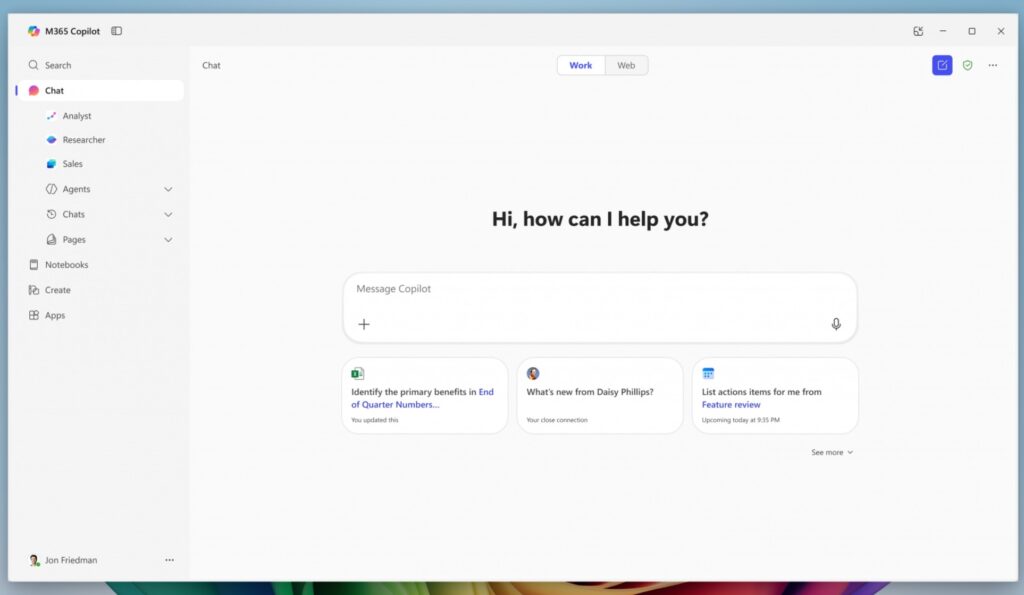
Microsoft is continuing to rebrand and redefine its AI strategy and products, with “agents” as the newest centerpiece. Going forward, even the Microsoft 365 Copilot app, in spite of its name, is going to be all about agents.
In September 2024, Microsoft made a number of announcements around Microsoft 365, agents and Copilot Pages, describing the collection of features as “Copilot Wave 2.” On April 23, Microsoft announced a further set of coming Copilot and agent deliverables as “Copilot Wave 2 Spring” release.
Microsoft’s biggest Spring Wave announcement is its plan to revamp the Microsoft 365 Copilot app sometime in May 2025. The Microsoft 365 Copilot app is what used to be known as the Microsoft 365 app or Office app. It is available on the web, on desktop (Windows and Mac), and on mobile (Android and iOS), and is the hub for commercial customers who want to interact with their Office apps and documents. Confusingly, the Microsoft 365 Copilot app does not require a Microsoft 365 Copilot subscription; it also is available to work and school customers with Entra accounts and consumers with personal accounts.
Microsoft 365 Copilot App To Become An Agent Showcase
The updated Microsoft 365 Copilot app will bear a strong resemblance to Microsoft Teams. The centerpiece is the Chat module (previously known as the BizChat and, on mobile, the Copilot module), which will give users access to chat history, Copilot Pages, and agents through the left navigation pane on the desktop and web versions. (Currently in the Microsoft 365 Copilot app, the Microsoft Search box is the centerpiece of the site.)
The updated Microsoft 365 Copilot app left navigation bar (or bottom bar on mobile) also will feature the “Create” button, as it does now, but with the revamp, Create will point to a new image generator based on OpenAI’s GPT-4o.
The revamped Microsoft 365 Copilot app will add some features already included in – or at least in the works for – the consumer version, such as the aforementioned image generation, personalization/memory and Copilot Search integration.
Copilot Search is based on Bing search but includes generative and large language model integration. Microsoft is touting that Microsoft 365 Copilot Search will work across both first- and third-party apps (like Google Drive, Slack, ServiceNow, Confluence, Jira, etc.). Microsoft Search already can do this via Microsoft Graph connectors. Update (April 29): According to the Microsoft 365 Roadmap, the Microsoft 365 Copilot search preview will begin in June, with general availability kicking off in August 2025.
The revamped Microsoft 365 Copilot app will include an Agent Store. This store will include agents from Microsoft and third-party developers. We have asked Microsoft whether the Agent Store is a rebrand of the App Store, but no word back so far.
Update (April 29): Microsoft officials said the Agent Store is completely separate from the App Store. The Agent Store will be generally available in May within Microsoft 365 Copilot, Microsoft 365 Copilot Chat and M365Copilot.com, Microsoft officials said.
Microsoft’s previously announced Researcher and Analyst reasoning agents will be in this Store and marked as “Frontier,” which is the new way Microsoft will refer to agents in early-access/preview that are available to those with a Microsoft 365 Copilot license while still in development.
Update (April 29): Many of the new features announced as part of the Wave 2 Spring release are not going to be available to Microsoft 365 Copilot Chat customers, Microsoft acknowledged. “Features like Copilot Notebooks, Create, and Skills agent are limited to customers with a M365 Copilot license,” a spokesperson said when we asked.
Copilot = The Browser for the AI World (?)
With agents becoming the newest AI darlings, Microsoft has been experimenting with various ways to talk about the relationship between agents and Copilots. One Microsoft exec said this week that Copilot acts “as the browser for the AI world.” Another Microsoft official said “Copilot is now your window into the world of agents.”
Jon Friedman, corporate vice president of design and research at Microsoft, made it clear Microsoft is still trying to position Copilot as a single entity, even though there are tens of different Microsoft Copilots which work and act very differently and draw from different data sources.
In explaining how and why Microsoft is revamping the Microsoft 365 Copilot app, Friedman told The Verge: “In my mind Copilot can be one branded experience, and it goes from warm and personal to performant and professional, and that’s what we’ve been working on together.”
I doubt I’m the only one who thinks this sounds a lot like the strategy Microsoft is continuing to try to land – not so successfully – with Free (consumer) Teams and commercial Teams.
Microsoft’s Copilot Wave 2 Spring Announcements
Microsoft’s Copilot Wave 2 Fall Announcements
Microsoft Plans for Improving the Management of Agents

Microsoft announced Unified Support, the replacement for its long-standing Premier Support program, in 2017. As of July 2022, Microsoft no longer offered Premier Support agreements for renewing commercial customers and as of July 2024, no longer for renewing public sector customers. (Some of these public sector customers still could be covered under Premier contracts through at least 2027, technically.)
Microsoft moved to its new Unified Enterprise Support plan in 2020. Unified Enterprise plans allow customers to choose from a menu of options around assessments, 24X7 technical support, case-management, and mission-critical services. But pricing for this menu of offerings isn’t per hour; instead, it is priced on a percentage-based model tied to customers’ overall Microsoft spending. The minimum contract price is $50,000 and rates start at 8% to 10% of customers’ annual Microsoft IT spend.
Many customers have complained about the high cost of Microsoft’s Unified Support. They’ve also publicly questioned Microsoft’s support quality, timeliness and more since Unified Support’s introduction.
What Can a Customer Do?
Many customers are confused about when and if they should seek out alternatives to Microsoft Unified Support. To that end, we’ve worked with one of the largest third-party Microsoft support vendors, US Cloud, * to assemble a list of some of the biggest myths around Microsoft support that we hear and see from enterprises.
Myth No. 1: Microsoft is your only option.
A surprising number of enterprises default to Microsoft when it comes to support – either because they don’t realize there are some excellent alternative qualified support vendors or because they are still in the “Nobody Gets Fired for Buying Microsoft” mode. Customers do have support options, and your support bill will likely be a lot less (as will your resolution times).
Myth No. 2: Microsoft Unified support is the safest support option.
Enterprises who are licensed for many Microsoft products often assume the most reliable and least risky option for support for those products would be Microsoft. But that assumption isn’t true. Good third-party support vendors employ Microsoft-certified product specialists and have channels for escalating issues directly to Microsoft if and when needed. The situation is not so different from how consumers often choose to buy extended support contracts from their preferred appliance store providers rather than the appliance manufacturers. Doing so can lead to faster, better, more customized support.
Myth No. 3: Microsoft does all its own support, making Unified Support the superior choice.
Unsurprisingly, Microsoft doesn’t go out of its way to acknowledge that it outsources a considerable share of Microsoft Unified Support to external vendors and contractors. As a result, there’s often little or no continuity for customers when it comes to working with the same support engineers across multiple engagements. Sometimes Microsoft’s contracted support people are located in different countries and time zones, which can make coordination and data residency requirements challenging. Don’t assume because it’s called “Microsoft Unified Support” that your support is coming directly from Microsoft or that it will be delivered in a unified way.
Myth No. 4: Enterprise customers are best served by renewing their Enterprise Agreements (EAs) and support contracts together.
Microsoft often encourages enterprises to renew their Enterprise Agreements and Unified Support contracts at the same time. Via this “coterminous contract” approach, Microsoft advocates for customers to bundle both agreements into their next renewal or risk losing a deal next time around. However, this practice of aligning termination dates actually results in customers having one less opportunity to negotiate terms in their favor. What looks like a customer convenience actually is more like a way for Microsoft to lock you into a deal that favors Microsoft.
*Directions on Microsoft has a business relationship with US Cloud via which we recommend our customers interested in third-party support engage with US Cloud during their Unified Support agreement negotiations.
Related Resources
Podcast: Microsoft Support: You’ve Got More Options Than You Think
From 2022: Premier Support Completes Transition to Unified Support (Directions members only)

As largely expected, Microsoft will be increasing prices of its on-premises servers by 10% beginning July 1 (the start of its fiscal 2026). Prices for on-premises SharePoint Server, Exchange Server, Skype for Business Server all will get the 10% hike. And prices for the Core Client Access License (CAL) Suite and Enterprise CAL Suite will go up 15 and 20 percent, respectively, as of July 1. Note: If you are a Microsoft Enterprise Agreement (EA) customer with exclusively E3/E5 users, you will not be affected by these changes, as all your use rights for the products in question already are included in your suites.
Update (June 27): While the price increases for on-premises servers are still on for July 1, the price increases for the CAL Suite and Enterprise CAL Suite are delayed until August 1.
July is also when the new Exchange Server Subscription Edition (SE) and Skype for Business Server SE will be generally available, Microsoft confirmed in an April 3 blog post. (Microsoft officials previously had said to expect the new Exchange and Skype for Business Servers to arrive in early Q3 2025.) In order to deploy these new releases, customers must have either active Software Assurance (SA) or cloud subscription licenses for all users and devices that access them.
Microsoft Exchange team officials said last year that Microsoft was planning to release the first Cumulative Update (CU) for Exchange Server SE in October 2025. That date now looks more like early 2026 at the earliest, based on information shared with Directions on Microsoft by Microsoft.
CU1 is significant for a couple of reasons. Once customers deploy Exchange Server SE CU1, they no longer will be able to mix and match older and new Exchange Servers in the same installation. This means that companies moving to Exchange Server SE will have to get 100% of their servers there before they have to apply CU1, yet another turn of the Exchange Server SE squeezer.
CU1 also is expected to be the vehicle for Microsoft to add support for Exchange Server SE for the new Outlook client for Windows. Currently, Microsoft doesn’t claim that the new Outlook works with on-premises Exchange (even though some customers seem to have found a way with a workaround and IMAP).
“The licenses price hikes, the cutoff of old versions, the weak link with new Outlook, they all point to a single message: If you care about Exchange e-mail, get off Exchange Server,” said Directions analyst Rob Helm.
A Separate Teams SKU Reprieve
In other licensing-related news, Microsoft is backtracking on a previous policy that required customers moving from EAs to Cloud Solution Provider licenses from having to purchase Teams SKUs for a few dollars more per user separately from their Microsoft 365 subscriptions.
“(P)artners who have customers with expiring Enterprise Agreements (EA) with Microsoft 365 E3 and E5 with Teams and Office 365 E1, E3, and E5 with Teams, which are end of sale (EOS), can renew into CSP and keep their Teams entitlement,” Microsoft said in an April 1, 2025, update to the Partner Center announcement site. Prior to this announcement, the standard policy for EA customers moving to CSP was that they were “net new” (to CSP) and thus could not purchase Microsoft 365 suites that contained Teams.
To qualify, customers must have EA agreement subscriptions expiring in the coming six months or EA agreements in the “grace period” (having expired in the past 90 days). Directions has asked Microsoft if there will be any way for other customers who previously were considered net-new because of the change in license/channel to be grandfathered into the “With Teams” bundle under the new rule. No word back so far.
Related Resources
Licensing and pricing updates for on-premises server products coming July 2025
Microsoft to add new monthly billing option, but at a 5% premium
Here’s another way to keep using classic Outlook (until at least 2029)
Exchange Server: Migrate Off Legacy Versions by Oct. 2025 (Directions members only)
What to know before you go Teams-less
The new ‘Net New’ rules for Teams
CALs Included with Online Services Suites (Directions members only)
Fifty years ago today, April 4, Microsoft got its start. A lot has transpired in that time. Microsoft has launched all kinds of products and services – from Azure to Zune. During that time, its three CEOs have weathered legal battles, executed many good (and not so good) acquisitions, and managed to change with the times better than just about any tech company still in existence.

Directions on Microsoft has been covering Microsoft through all its phases for more than 30 of those years. Some of our analysts previously worked at Microsoft; others worked for Microsoft partners and Microsoft enterprise customers. So who better to take stock of Microsoft on this momentous occasion than the Directions analysts.
Donning my journalist hat, I asked our analysts three questions:
- What product, strategy, or event from Microsoft’s first 50 years do you still consider impressive (for its time or even to this day)
- What’s one (and only one!) product or strategy that you consider/considered ill-advise
- What’s one tip you’d give enterprise customers who will be sticking with Microsoft for at least part of its next 50 years
Their answers may (or may not) surprise you.
The good: SharePoint, the product that has endured. In 25 years, it’s grown, morphed and transformed from server product to cloud behemoth, birthed a global community of evangelists and events, and spawned an eco-system of vendors and products. With the introduction of M365 Copilot, it transformed once again as a gold mine of organizational data for a new generation of productivity apps.
The not-so-good: Windows Phone – When Microsoft introduced the Windows Mobile phone in about 2004, it failed to innovate and may have lacked vision as it rapidly lost share to Apple’s iPhone when launched in 2006 and later, Android. Buying Nokia in 2011 was arguably Microsoft’s last significant effort to retake market share but it may not have been the best option. While not a cure-all, RIM’s Blackberry may have been a better acquisition at the time with its secure email server, corporate clients and younger global consumer base for its Blackberry Messenger (BBM) service.
Your tip: Stay flexible, my friends. Technology is changing faster than ever, and quantum computing is on the horizon. Maintain a flexible IT structure and organization for the adoption of new technologies Microsoft will introduce. Invest in training to keep your workforce engaged and its skills current.
The good: Microsoft has an extraordinary, maybe even unique ability to cross chasms. The technology industry – indeed, all industries – are littered with the dead, decaying corpses of once-high-flying companies that couldn’t adapt: Digital Equipment, Wang, Lotus, Compaq, (maybe even) Intel. Microsoft, unlike any other company I can name, has demonstrated an unparalleled and frankly historic ability to confront, surmount, and thrive through paradigm shifts: GUIs, client-server, internet, cloud, AI. It’s really quite extraordinary.
The not-so-good: Fighting the United States government. Microsoft’s long war with the Department of Justice over anti-trust consumed it for years, depressed the stock price, and hurt its reputation – when resources would have been better devoted to innovation. The good news is that they appear to have learned from it with a proactive CELA team working with, instead of at odds with, governments both in the US and globally.
Your tip: Do what’s right for you. Microsoft positions itself, to the extent it can, as one-stop shopping. Know your requirements, do your homework, comparison-shop, negotiate, and bargain. Microsoft may well have the right products and services for you, but being an informed customer is better for you, your organization, and ultimately for Microsoft.
The good: Microsoft retaining the rights to sell DOS to other companies, besides IBM. Because the original IBM PC (code-named Acorn) was made mostly from off-the-shelf components, everything except the ROM-BIOS was available to and from other manufacturers. By reverse engineering the BIOS, IBM PC clones came to the market from a variety of vendors such as Compaq. This established the PC as a highly-configurable device that could run a wide variety of applications—creating the foundation for Microsoft to truly be a software company.
The not-so-good: Not realizing that the antitrust case would be tried in a court of law, rather than the court of public opinion. In the former realm, Microsoft did not have the smartest people in the room, merely the most arrogant.
Your tip: In the words of Ronald Reagan, trust but verify. Almost anything anyone at Microsoft tells you is accompanied by a significant amount of sales puffery. It is not that the product or service won’t work, but it won’t always work as advertised. The weird thing is, they believe what they are saying, and eventually it may all come to pass.
The good: Microsoft’s move to the enterprise datacenter. If you told me, back in the days of Windows 3.x running on top of DOS, that nearly every Fortune 1000 company would have Microsoft software (let alone Windows!) in their data centers and powering their business, I’d have said you were nuts. But it happened. A lot of the credit goes to Dave Cutler and the early Windows NT team – they built the foundation of the modern Microsoft.
The not-so-good: Its obsession with consumer business. I don’t know why, but even as they make literal billions of dollars selling to businesses, the company has an inferiority complex around consumer business. So they keep trying to do things like Zune, or Xbox, or Bing. The only thing those efforts do is set money on fire and serve as internal distractions.
Your tip: Keep Microsoft honest. The best way to control Microsoft costs has always been to have a credible alternative. Nothing makes the sales team sharpen their pencils more than a plausible plan to move to Linux. So keep them honest, invest in the due diligence needed to have an exit plan, even if you hope not to use it.
The good: In terms of strategy, I’d say that the bundling of the Office suite back in the 1990s remains a masterstroke. Back then, all the business apps were standalone. Companies used WordPerfect, and Lotus 1-2-3, and dBase. What we take for granted as an office suite today was all individual programs. Microsoft’s products weren’t the strongest in their respective categories, but they were good enough in comparison and less expensive as a bundle than buying the individual best of breed programs. In the corporate world, where purchase decisions are usually made by finance rather than the actual users, that made buying Office the go-to choice (it’s good enough and saves us money!) and helped make it the corporate standard it has become.
The not-so-good: Can I call out an entire category? Microsoft as a “consumer technology” company ended in the mid-late 1990s. With the exception of Xbox, Microsoft has had few wins of any measure there – and Xbox might have arguably flopped at launch if they hadn’t bought Bungie (the makers of Halo). So many of their attempts in that area have been utter misses either because they think of the technology first and the customer second, or because they’re more concerned about partners than the actual customers (such as the awful licensing terms for music purchased on Zune).
Your tip: Microsoft’s an amazing technology company, but a lot of their financial success comes from bundling, licensing, and carefully choosing their direct customers – who are often OEMs, resellers, or even corporate procurement officers rather than the actual end-users of their products and services. It’s a strategy that’s worked well for decades and they’re very good at it. Keep that in mind as you continue to use their products in your enterprise; understand who their real customers are, and you’ll have a better handle on how to work with them in the future.
The good: “Island driving”: As a business, Microsoft’s primary strategy over 50 years has been to expand from one monopoly (PC operating systems originally) into a new one with a few basic tactics such as bundling and volume discounting. The monopoly business always gave Microsoft something solid to go back to, lick its wounds, and try again — it never really had to “bet the company”.
The not-so-good: Consumer brand envy. Competitors have been a great source of inspiration for its engineers, but the long rivalries with consumer brands like Apple, Google, Sony, and so on took billions out of investor’s pockets. Pursuing consumer Internet business did teach Microsoft how to run large data centers, however, which positioned it to enter cloud application and infrastructure services. And crashing in mobile and (initially) cloud infrastructure also cleared the way for Satya Nadella to become CEO.
Your tip: Diversify. For every category where Microsoft is a big component of your IT spending, make sure there’s a credible competitor with at least a small foothold in your business. And as Microsoft continues to expand in the cloud, you can be one of those competitors, by retaining staff and vendors who can run at least part of your data center infrastructure.
The good: Windows 95. An amazing product at the right time from an incredibly small team (by comparison to today) that changed the world. Outside of Xbox, the last time anyone stayed up until midnight to buy consumer computing technology from Microsoft at a store.
The not-so-good: Windows Home Server. Sure, it had a small hobbyist market that it could appeal to – but the market for such a product was always extremely small. It was in many ways a product of Microsoft employees for Microsoft employees (or nerds of a feather.)
Your tip: Be prepared to pay more than you want – prices rise and strategies change… you will need to iterate more rapidly on product versions than you ever had to in the past.
The good: I keep coming back to Visual Basic on this one. It opened up GUI programming to a wide audience and influenced the way desktop apps would be designed for decades. It led to VBA, which still lives. And its tools performed surprisingly well on the hardware back in the day thanks to portions of it that were implemented in assembly.
The not-so-good: Someone’s gotta say Microsoft Bob here, so Bob. Although, if generative AI were available back then…
Your tip: There will always be a lot of noise coming out of Microsoft, but within that there is always a strong signal. Enjoy the noise, but stay alert, and keep fiddling with the tuning knob (using Directions, for example) to clear away the fuzz.
The good: It’s got to be SQL Server. A beautiful product from the beginning to now. Met the needs for easy query and robust performance and security that others are still trying to emulate.
The not-so-good: Windows ME. Two concerns: 1. Never let the interns influence product design. 2. You don’t always need to rewrite things.
Your tip: Watch the pendulum swing. There’s a resurgence of moving back on-prem for a reason. Many are finding it too expensive to be in the cloud. But realize (tip 2) that on-prem will come with subscriptions now. You’re on the annuity train.
Having covered Microsoft for more than 40 years myself, I can’t resist weighing in, too:
The good: I COULD say Notepad here and call it a day. But I’d also be remiss not to mention Microsoft’s development and launch of Azure. This was an impressive feat for a company with very little cloud experience to come together and pull this off fairly quickly and, largely, in secret.
The not-so-good: Microsoft’s decision to go ahead and launch Windows 8 after all the negative feedback from enterprises who knew a touch-first experience would not work for businesses. I’m still befuddled that this happened, but glad Windows 8.1 and then, 10 didn’t take all that long to come to the rescue.
Your tip: Remember that Microsoft’s ultimate goal is to make you dependent on its cloud and to upsell you to its priciest subscriptions (no matter what they say publicly about customer choice). Plan and negotiate with that in mind.
A new Windows Roadmap from Microsoft documents some major and minor improvements that may become generally available in the near term, and provides information about some changes already in preview or generally available. However, it appears incomplete and downplays the reality that many Windows 11 users cannot access last year’s Windows 11 Annual Feature Update (24H2), which is still being throttled while Microsoft attempts to fix problems.
Filtering Required
One nice feature of the new roadmap is the ability to filter the entries based on a variety of criteria. For example, information can be filtered by Platform (Windows 11 PC versus Windows Copilot+ PC), Version (23H2 versus 24H2), Status (Preview versus Generally Available), and Channel (Retail versus Insider). For example, selecting “Windows 11 PC,” “23H2,” “Gradually Rolling Out,” and “All” shows five entries that started rolling out in Mar. 2025:
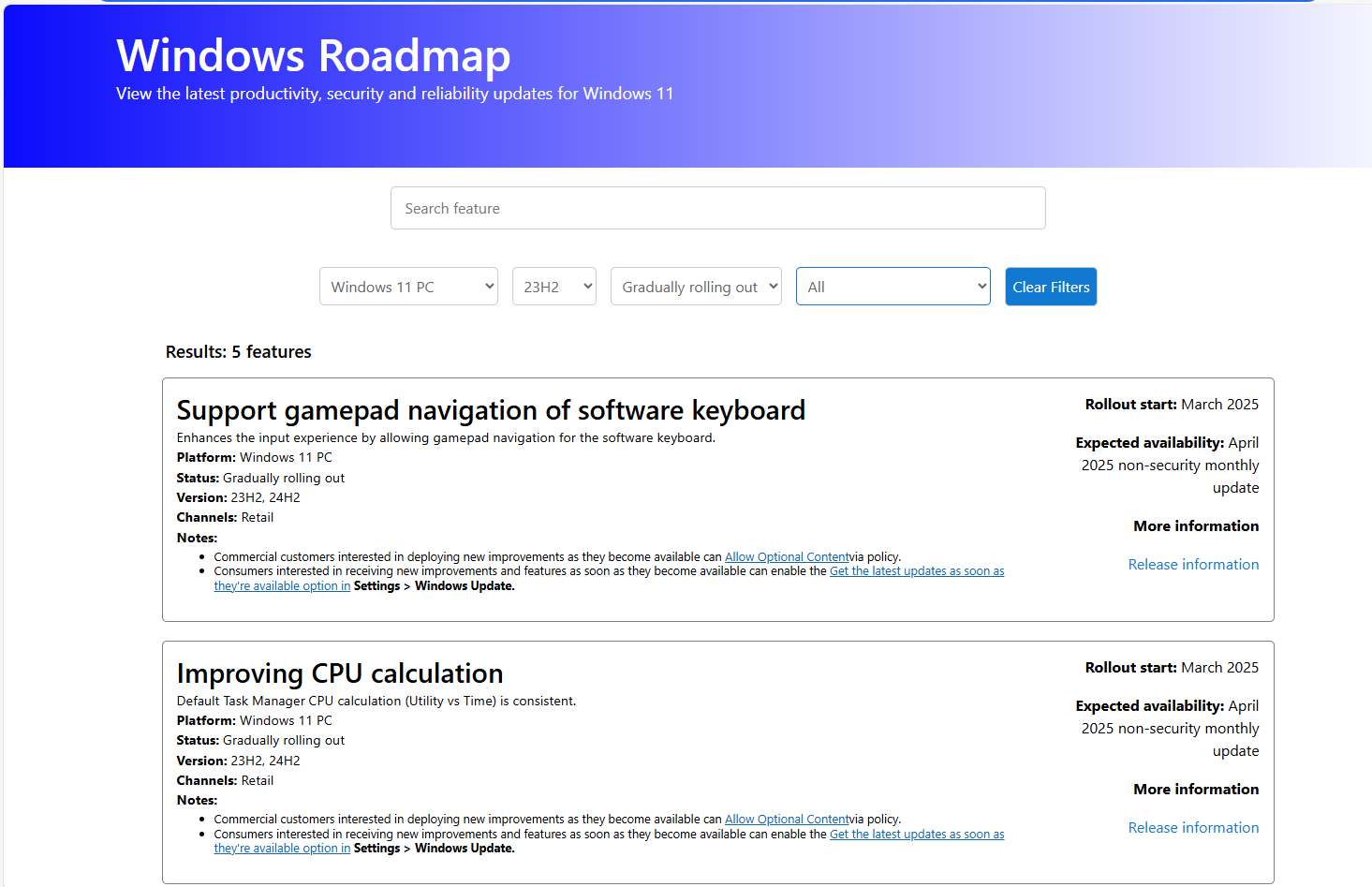
In addition to the information used to filter the entries, each entry also provides data such as the Rollout start, Expected availability, More (release) information, and Notes, with entries such as where customers can get the update.
Many Features Not Enterprise Focused
Many of the features in the roadmap are not likely to interest enterprises. For example, “Support gamepad navigation of software keyboard,” is more relevant to consumers, whereas “Improved CPU calculation” may interest consumers and Enterprises. But perhaps a bigger issue with the roadmap is that it has significant gaps. For example, searching for “Quick Machine Recovery” does not find a roadmap entry for work Microsoft is doing to automatically detect, diagnose, and resolve critical issues, which is now available in the Windows Insider Preview Beta Channel for Windows 11, version 24H2. This feature helps when a device gets stuck in the Windows Recovery Environment (Windows RE), which can require considerable time and expertise to resolve.
Getting a Complete Picture
If I were designing this kind of roadmap, I would merge what they’ve built with the known issues with Windows 24H2, so that customers might now when they would be able to get the latest Annual Update. After all, with Windows 11 24H2, it has been six months since general availability, and many users still are not able to get the update, while others are suffering from widespread problems and a general lack of stability after updating. These people will not get the value of the full term of the 24H2 support window through no fault of their own.
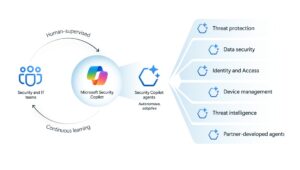
For Microsoft, 2024 was a big year for filling out its Copilot line-up. So far, 2025 looks to be the year of the agents.
Microsoft is planning to add several security-specific agents to its Security Copilot later this year. They will be available in preview in April, according to the company.
Microsoft made its Security Copilot available for Microsoft 365 commercial customers in April 2024. Security Copilot is a set of capabilities that integrate data from numerous Microsoft 365 services and Microsoft Sentinel and is available in its own console, as well as the Microsoft Defender XDR portal. Security Copilot is billed using a complex and confusing “Security Compute Unit” (SCU) meter of US$4/hour for the time the service is provisioned and used each month.
As opposed to assistants like Security Copilot, which are focused on UI/user interaction, agents are meant to autonomously handle specialized, multi-step tasks, alone or in concert with one another.
Agents: ‘The natural evolution of Security Copilot’
Microsoft officials say these coming agents “represent the natural evolution of Security Copilot” by managing high-volume security and IT tasks. They will provide automation across areas like threat protection, identity management, data security and more, officials said.
Microsoft’s newly announced Security Copilot agents include:
- Phishing Triage Agent in Microsoft Defender for handling phishing reports
- Alert Triage Agents in Microsoft Purview for data loss prevention and insider risk alerts
- Conditional Access Optimization Agent in Microsoft Entra monitors for new users or apps not covered by existing policies
- Vulnerability Remediation Agent in Microsoft Intune monitors vulnerabilities and remediation tasks
- Threat Intelligence Briefing Agent in Security Copilot for curating threat intelligence.
Microsoft also is working on a Purview-specific solution, Purview Data Security Investigations, which will help teams analyze data-exposure risks using AI. Beginning April 9, DSI will be available in preview for admins and will require Purview pay-as-you-go and Security Copilot Security Compute Units.
In its blog post announcing the new Security Copilot agents, Microsoft also touted additional new agents for Security Copilot from various partners, including:
- Privacy Breach Response Agent from OneTrust
- Network Supervisor Agent from Aviatrix
- SecOps Tooling Agent from BlueVoyant
- Alert Triage Agent from Tanium
- Task Optimizer Agent from Fletch.
In related news, Microsoft is extending its ability to use Microsoft Defender to manage the AI security posture of models beyond Azure and Amazon Web Services (AWS) to include Google VertexAI, plus all models in the Azure AI Foundry model catalog. This capability will be in preview starting in May 2025 and will include Gemini, Gemma, Meta Llama, Mistral and custom models.
Microsoft is hosting a free, one-hour AI security virtual event, Microsoft Secure, on April 9, where company officials will provide more information and demos about Security Copilot, these new agents and other related tools. It plans to expand on these topics at the upcoming RSA Conference 2025 from April 27 to May 1 in San Francisco. For Microsoft, 2024 was a big year for filling out its Copilot line-up. So far, 2025 looks to be the year of the agents.
Related Resources
Microsoft announces new Security Copilot agents
Security Copilot generally available; value limited (Directions members only)
Data Security Investigations with AI
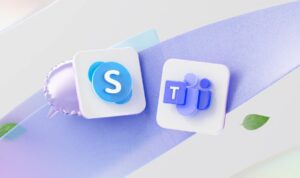
Microsoft is advising customers to replace its Skype consumer communications service with the consumer-focused Teams Free. But some customers may prefer to go elsewhere for their Skype replacement.
Microsoft will finally discontinue its Skype consumer calling service in favor of Teams on May 5, 2025, after years of expectations that the company would do so.
Microsoft’s Feb. 28 acknowledgement that Skype’s days are finished comes 14 years after Microsoft bought Skype for $8.5 billion, its largest acquisition to date at the time.
Microsoft is advising customers who still are using the Skype consumer service to move to the consumer-focused Free version of Teams. Microsoft says existing Skype users will be able to log into the Teams app and have their contacts, message history and more available automatically or opt to export their data from Skype to Teams. According to the announcement, if customers take no action by May 5, it will retain the user data until the end of 2025, when it will be deleted.
As part of the Skype phase-out, Microsoft is dropping support for calling domestic or international numbers through Skype. Those with Skype credits and subscriptions can continue to use them inside Teams until the end of their next renewals only, and current Skype Number users will need to move to a different provider.
There is no equivalent ability to buy calling only in consumer Teams, and calling in commercial Teams requires Teams Phone — an additional cost that requires more administration and management.
“In short, not only is Microsoft ending Skype, they’re ending consumer-facing calling service,” said Directions on Microsoft analyst Jim Gaynor.
However, with the growth in use of Skype alternatives such as WhatsApp, Zoom, and Telegram, Teams Free isn’t the only, or even most obvious, Skype alternative.
Skype for Business Server Marches On
Microsoft introduced Teams in 2017 and the consumer version of Teams in 2020 —which was built on a rearchitected back-end shared with Skype. When asked about Skype’s future after Teams’ introduction, Microsoft execs repeatedly said they believed there was a distinct need and place for Skype alongside Teams. But now they are saying they feel like they are in a good place with Free Teams.
Before Teams evolved into an enterprise-ready platform, Skype was a reasonable choice for businesses that wanted voice service for branch offices in other countries, and to talk to consumers for customer service or the like.
Microsoft’s announcement of the planned death of Skype has no bearing on the future of Skype for Business Server. In spite of claiming feature parity between Skype for Business Online and Teams in 2018, Microsoft continued to support Skype for Business due to customer demand.
Microsoft is planning to roll out Skype for Business Server Subscription Edition (SE) this year, just ahead of the end-of-support for Skype for Business 2015 and 2019 in Oct. 2025. (Microsoft discontinued its Skype for Business Online service in 2021.)
Related Resources
On the Path to Skype for Business Server SE (Directions members only)
From 2017: Skype as a Commercial Service (Directions members only)
Teams Phone Services Detailed (Directions members only)

Just a few days after the newest AI industry darling DeepSeek unleashed its latest model and app for free, Microsoft made DeepSeek’s R1 available in its own model catalogs.
Microsoft officials said that R1 is available via its own GitHub and Azure platforms. DeepSeek R1 on Azure AI Foundry platform is supported with “automated red teaming, content safety integration, and security scanning,” Microsoft officials said. Microsoft already offers more than 1,800 models, including industry-specific, frontier, and task-based models, via its catalogs.
DeepSeek is a Chinese startup founded by the Chinese stock trading firm High-Flyer. It is building products that will compete head-to-head with OpenAI’s ChatGPT and Google’s Gemini.
On Jan. 29, Microsoft also committed to making “distilled flavors” of R1 able to run locally on Copilot+ PCs “soon.” Microsoft plans to make NPU-optimized versions of R1 available for devices starting with those based on Qualcomm Snapdragon X, and later also on Intel Core Ultra 200V. (Some people already have downloaded R1 to their Windows PCs running various processors and are running it locally.)
Over the past few years, DeepSeek released various large language models and in Jan., it delivered its first chatbot app called DeepSeek-V3. Last week, DeepSeek released R1, along with a white paper claiming it could train its systems far more cheaply than the current group of AI leaders. DeepSeek’s code is largely (though not completely) open source.
The same day that Microsoft made R1 available on its own platforms, Microsoft and its partner OpenAI claimed DeepSeek may have copied output from ChatGPT beginning last fall. (As many industry watchers have pointed out, OpenAI is under scrutiny — and some lawsuits — for allegedly copying content from various companies to train ChatGPT.)
DeepSeek Doesn’t Spell the End of Microsoft’s Cloud, AI Spending Spree
Microsoft committed earlier this year to spending US$80 billion during fiscal 2025 (July 1, 2024 to June 30, 2025) on building out datacenters and supporting infrastructure, much of which will be dedicated to supporting AI.
Microsoft CEO Satya Nadella continues to maintain that Microsoft has been expecting AI costs to fall as large language models become increasingly commoditized, which will lead to more demand for those technologies. During the company’s FY25 Q2 earnings call on Jan. 29, Microsoft officials gave no indication that the company plans to reduce this spending, even if these costs fall, because running commercial-cloud apps and services will continue to require more compute, storage, and other building block pieces.
During Microsoft’s second quarter of its fiscal 2025, the company spent $22.6 billion, largely for building out its cloud and AI offerings, and is anticipating spending similarly in the next two quarters. In FY ‘26, however, Microsoft is expecting capex spending rate to slow a bit, officials said, with spending shifting back to assets that will directly impact revenue growth.
Microsoft also said during the Q2 earnings call that Azure and “other cloud services” grew 31 percent in Q2 year-over-year, which was down a couple of percentage points from the rate in previous quarters. Supply constraints were in part to blame for the slower growth rate, officials said. Thirteen points of Azure’s contribution in Q2 came from AI services growth, according to Microsoft.
Commercial bookings were up 67 percent year-over-year during the quarter — more than double the percentage of most recent quarters. Microsoft execs attributed that large number to a new large unspecified commitment from OpenAI, along with new commitments from new and existing customers; add-ons and upsells; E5 subscription growth; and demand for various Copilots.
Microsoft cloud revenues for the quarter were $40.9 billion. Total AI revenues are on track to surpass $13 billion annually, officials projected.
Related Resources
Microsoft releases DeepSeek R1 on Azure Foundry, GitHub
Microsoft says ‘distilled flavors’ of R1 coming to Copilot+ PCs ‘soon’
OpenAI, Microsoft call foul on DeepSeek’s training methods
Microsoft FY25 Q2 by the Numbers

Microsoft has been planning to quick-march customers of its Exchange Server enterprise e-mail software to subscription licensing with the coming Exchange Server SE release. But a key piece in its plan is late, which means customers will have to march even quicker.
Central to Microsoft’s plan is Exchange Server SE (subscription edition), which Microsoft has said will be available early in the third quarter of this year. Exchange Server SE will be the first new on-premises release of Exchange since Exchange Server 2019. Like SharePoint Server SE and Skype for Business SE, the coming Exchange release will require a subscription (or Microsoft’s subscription-like Software Assurance) in order to receive updates and security fixes.
Very shortly after Microsoft releases Exchange Server SE, both Exchange Server 2016 and 2019 will no longer be supported by Microsoft. On Oct. 14, 2025, customers of Exchange Server 2016 and 2019 will have to either leave Exchange Server for a cloud replacement (such as Microsoft’s Exchange Online) or move to Exchange Server SE.
To help customers comply with its tight roadmap, Microsoft planned to release an update to Exchange Server 2019, Cumulative Update 15 (CU15), which officials said would transform that Exchange Server 2019 into a product virtually identical to Exchange Server SE.
Update (February 10): Microsoft announced that it is making CU15, also known as the H1 2025 Cumulative Update for Exchange Server 2019, generally available as of today, February 10, 2025. Back to the rest of our original blog post:
CU15: Still a No-Show
However, CU15 has gone missing. In May last year, Microsoft said to expect CU15 sometime in the second half of 2024. In Sept., Microsoft quietly updated its blog post about its Exchange Server rollout roadmap by changing the CU15 due date to “H1 2025.” But then in Dec. 2024, officials said CU15 was on track to release in early Jan. 2025.
Directions on Microsoft asked Microsoft last week for an update on CU15’s release. After telling us the company had no comment, Microsoft released on Jan. 31 a blog post with answers to the questions we asked.
In the post entitled “When is Exchange 2019 CU15 coming (and more news),” company officials said they are still not ready to publicly release CU15 due to some unspecified “late issues” discovered by customers in its Technology Adoption Program.
But “We are almost ready for the release,” officials stated. (We analysts are not holding our breath at this point.)
Officials reiterated that Microsoft is not going to push back the timing of the RTM version of Exchange Server SE, which is still due in early in the second half of calendar 2025. In spite of the ongoing CU15 delays, Microsoft also is not postponing the end of support for Exchange Server 2016 or 2019; both still will get no more updates or security patches after Oct. 14, 2025.
A New Wrinkle: CU14 Supports Windows Server 2025
The blog post also said that Microsoft has updated Exchange Server 2019 CU14 so that it can run on Windows Server 2025 “so customers can build new servers on new hardware and OS.” Support for Windows Server 2025 was one of the features Microsoft had promised for CU15.
Customers posted a number of questions about this new revelation in the comments section of the blog post. They asked whether they would be able to upgrade Exchange 2019 CU14 directly to Exchange SE. They wondered whether CU14 supported the Windows Server 2025 Domain/Forest Function Level. They asked if the prerequisites would remain the same for CU15/SE. Microsoft had not responded to any of these questions as of Feb. 3.
One Silver Lining
There is one silver lining to this delay: It suggests that Microsoft is treating CU15 like a full-blown product release and taking the time to test it thoroughly, said Directions on Microsoft analyst Rob Helm.
In the end, customers determined to keep their e-mail systems on-premises or in hosting at a third party have to upgrade to Exchange Server 2019 (if they are still running the 2016 version). They can then use the time waiting for CU15 to do data archiving or other clean-up projects that could make the upgrade to SE go more quickly. They can also line up the people, labs, and other resources to deploy CU15 as soon as possible after it arrives.
A reminder: Exchange Server SE CU1, due in late 2025, will kill support for coexistence with Exchange Server 2016 and 2019 servers, eliminate the 2010-era Outlook Anywhere protocol, and deliver other possibly disruptive changes. Directions asked Microsoft if there would be any exceptions for customers who might need to run older versions while migrating from 2016 or 2019 to SE. Microsoft officials did not provide an answer to that particular question in its blog post.
Related Resources
Exchange Server SE: Coming to You in Q3 2025
When Is Exchange Server 2019 CU15 Coming?
Exchange Server 2016 and 2019: T-9 Months and Counting

Given Microsoft’s constant drumbeat around AI and Copilots in 2024, it’s not too surprising that the Directions on Microsoft members flocked to our coverage of those topics on our site. But the new Outlook, Microsoft Fabric, Extended Security Updates and non-subscription Exchange and Windows Server releases all were top of mind, too, as evidenced by page views on our web site. We believe what mattered in 2024 is a good indicator of what Microsoft customers will likely care about in the coming year.
Some of our Directions on Microsoft coverage is exclusively for our members and behind our paywall. When looking at traffic for those stories in 2024, our analyst reports on Copilots — everything from how to secure them, to how to evaluate them — dominated. We got a lot of reader questions about how to prepare their data for Copilots and how to calculate ROI to justify their use.
We created a regularly updated Copilot Comparison chart to help customers try to keep up with the naming, positioning, pricing and licensing changes of Microsoft’s main enterprise Copilots (and are making it available to non-members too, if they fill out this form). Given Microsoft’s emphasis in its own content on Copilot security and ROI last year, it seems like our members were not alone with these questions.
What Else Was on Enterprise Customers’ Radar?
But our most-trafficked Microsoft enterprise topics on our public blog (https://www.directionsonmicrosoft.com/blog/) tell a more expansive story, in terms of what Microsoft customers cared about in 2024. Here are our 10 blog posts in 2024 which received the most page views, ranked from highest on down:
1. Microsoft to support Classic Outlook for Windows for Some Until at Least 2029: Fear and loathing of Microsoft’s new Outlook continued in 2024, with many customers desperately seeking ways to continue to use Classic Outlook for as long as they can while Microsoft tries to add many of the key classic Outlook features to its new Outlook client. (We’ve been keeping close tabs on Microsoft’s feature list and hints about end-of-support dates and will continue to provide the latest details on this in 2025 and beyond.)
2. Ten Things You Need to Know Before Buying Microsoft 365 Copilot: This Nov. 2023 blog post, which we posted on Nov. 1 — the day Microsoft deemed M365 Copilot as “generally available” — included a number of hard-to-discover tidbits that many Copilot-curious customers still may not know. Even though it was posted in late 2023, it continued on to get lots of visits in 2024.
3. Exchange Server Subscription Edition: It’s Happening in Q3 2025: In May, Microsoft broke its two-year silence about what was next for Exchange Server. Customers are going to have to act quickly this year to stay supported (and the same applies for customers still using Skype for Business Server!)
4. Microsoft Fabric Takes Control of Power BI Licensing: Microsoft announced plans to retire several Power BI licensing and purchasing options, requiring customers to purchase new Fabric licensing and migrate existing workspaces. That’s one (not-so-great) way to get users to migrate to a new service.
5. Microsoft Adds Another Way to Get Windows Server 2012 and 2012 R2 Extended Security Updates: ESUs are an expensive way to continue to get security updates for Microsoft products that the company is no longer supporting. But there are other alternatives, including Azure Arc server enrollment (with some caveats).
Power BI, Paid Add-Ons and More
6. Microsoft’s Office LTSC 2024 Begins Rolling Out: Microsoft is all about subscription-based products, but not all customers are. The latest (but not final) non-subscription-based, perpetual version of Office launched in 2024 for commercial and volume-licensed government customers.
7. Microsoft VLSC Features Moving: Back in 2023, Microsoft began moving some of its Volume Licensing Service Center (VLSC) features to the Microsoft 365 Admin Center (MAC). In 2024, customers continued to be curious about where their cheese was moved.
8. Power BI Customers Beware: The Fabric Takeover Continues: Microsoft continued its push to get more customers to adopt its Fabric data analytics platform with strong-arm tactics, including retiring high-end Power BI features with Fabric as the only replacement option.
9. Paid Add-Ons to Microsoft 365 Are Multiplying: What’s a Customer To Do: Extra-cost features, apps and licenses that go beyond what’s included in the base Microsoft 365 E3 and E5 subscriptions grew more than four times over the past four years. Expect this trend to continue in 2025 and beyond.
10. Microsoft’s Remote Desktop Services days are numbered: Here’s Why: We warned customers in 2023 that even though Microsoft has not announced an official end-of-support date for its Remote Desktop Services (RDS) role for Windows Server, its demise looks increasingly likely. Support for RDS is expected until at least 2026, but it’s high time for users to be considering other options.
Thanks for reading! If you have any topics or questions you’d like the Directions analysts to tackle in 2025, reach out and let us know.
Related Resources
Directions’ Copilot Comparison Chart: Download the Latest Version
Directions’ Microsoft Copilots Kit (Directions members only)
Microsoft Copilots Timelines (Directions members only)
Microsoft Copilot Fundamentals (Directions members only)
How to Make Copilots Compliant (Directions members only)
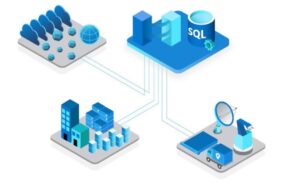
The concept of a “polymath” became popular during the renaissance, when intellectual figures such as Galileo and da Vinci were expected to be well versed in the cutting edge of mathematics, physics, art, medicine, philosophy, and more. But somewhere along the past 400 years, knowledge has become too specialized for any one person to really master. I love Neil deGrasse Tyson and if I’m interested in what happened during the first few milliseconds after the Big Bang, Neil is my man. But as smart as he is, if I think I’ve ruptured my appendix, I’m going to look elsewhere.
Since its introduction in 1989, SQL Server has aimed to be a polymath of databases, incorporating more and more distinct use cases offered by other databases under one umbrella. OLTP? Check. Analytics and Warehousing? Check and check. And with the latest release, SQL Server 2025 — currently in private preview — Microsoft aims to run that play that once again. My Directions colleague Rob Sanfilippo outlines the new features in an upcoming report, but the one that leapt out to me was the inclusion of vector database capabilities.
SQL Server’s Next Trick: It’s All About AI
Vector databases are increasingly important for retrieval-augmented generation (RAG) AI applications because they encode and search as vectors the kinds of multi-dimensional data often used within AI models. Not surprisingly, that has led to a slew of new databases, both open source and commercial, aiming to capitalize on the demand for database engines specifically designed for vector data. But for the SQL Server team, the first commandment is “I am thy database SQL Server. Thou shalt have no other databases before me.” Because of this, the idea of a database use case where the answer can’t be “use SQL Server” is untenable.
Enter SQL Server 2025. To be honest, I have no idea exactly how the new releases’ vector features really compare to products like Pinecone or Milvus. SQL Server 2025 is only now entering the private preview stage and the entire field of RAG applications is still developing rapidly. But I do know that the ability to store, index, and search highly multi-dimensional, unstructured data requires very different architectural choices than traditional tabular data. And I know that combining SQL Server (literally, a child of the 1990s) with vector databases — which didn’t appear as a purpose-built product until the launch of Milvus in 2019 — inevitably implies that some gotchas are there, waiting to be discovered.
What’s an Enterprise Customer to Do?
What does this mean to enterprise customers? It all comes down to what you are optimizing for and who is making the platform decision. Operations teams will bias towards fewer systems to manage and the procurement team will love the idea that they don’t have to navigate license agreements with a new vendor. Microsoft has made a handsome living appealing to both of those constituencies.
But the point is, none of that matters unless you know for certain that you’ve given your app dev teams the freedom to evaluate all the possibilities with in-depth proof-of-concept development and found out where the limits are for your unique combination of use case, data types, and workload. Vector databases and RAG are so new that nobody can make sweeping declarations about what will or won’t work.
Who knows, maybe the idea of a polymath database has a bit more life in it yet and Microsoft can extend SQL Server one more time into a totally new realm. They have done it before with the addition of column storage, in-memory indexing, and even graph data that works surprisingly well. Maybe they have a trick up their sleeve that can take SQL Server into the AI era.
For me, it’s time for my annual physical and as much as I respect him, I think I’ll let Dr, Tyson take the day off and go see a medical specialist instead.
Related Resources
Microsoft: Apply for the SQL Server 2025 Preview
Understanding Embeddings, Vectors, and Vector Databases (Directions members only)
Get a Free Sample of the SQL Server section of our Database, Analytics and AI Roadmap
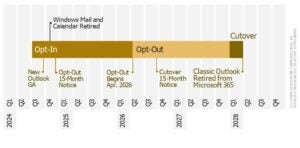
Microsoft 365 enterprise customers have a slightly firmer date when the “classic” Outlook for Windows app will be ejected from their Office suites and replaced with “new Outlook.” On Dec. 6, Microsoft announced it will start the Opt-Out phase of new Outlook’s rollout in Apr. 2026. By then, customers who buy Office through Microsoft 365 (formally known as Microsoft 365 Apps for enterprise) should be ready to either accept new Outlook and the possible breakage it brings, or block it in favor of classic Outlook, until the mandatory Cutover to new Outlook.
Directions on Microsoft’s diagram, embedded in this blog post, shows one way things could play out. If Microsoft runs Opt-Out for 18 months starting in Apr. 2026, the “Cutover” phase starts in early 2028. In this scenario, Microsoft will remove classic Outlook from Microsoft 365 Apps for enterprise by the second quarter of 2028, but it still will be available as a separate download for Microsoft 365 Apps for enterprise customers until 2029.
Directions on Microsoft members can find our advice and more details in our (frequently updated) full report M365 Customers Can Keep Classic Outlook Until at Least 2029. If you have Microsoft 365 Message Center read privileges, you can find Microsoft’s announcement of the Opt-Out phase in MC949965, Toggle to new Outlook.
Related Resources
M365 Customers Can Keep Classic Outlook Until at Least 2029 (Directions members only)
New Outlook for Windows: A Guide to Product Availability
Here’s another way to keep using classic Outlook (until at least 2029)

I’ve always been fascinated by hardware – and today innovation is happening faster than ever. Whether it’s tuning existing server chips for the specifics of the public cloud, building new chips optimized for specific workloads, or offloading some of the overhead of public could infrastructure to increase performance, custom silicon processors are becoming increasingly popular with public cloud providers. Over the past few years Microsoft has begun to develop its own custom silicon processors for Azure. Arguably, they remain behind their chief cloud competitors — AWS and Google Cloud — but the company clearly sees that specialized, proprietary hardware could be a competitive advantage. But is Microsoft doing enough and how do its chips stack up?
Cobalt: ARM-Based CPU
Following the lead of AWS and others, Microsoft released its Arm-based CPU into general availability in October 2024, for use in Azure VMs (the Dpsv6 and Epsv6 series, not available in all regions). Cobalt is not Microsoft’s first Arm-based processor; VMs with Ampere’s Altra processor were introduced in 2022.
Cobalt, a 64-bit processor, is built by the Taiwanese chip foundry TSMC using a 5nm process and can support 96 vCPUs and up to 192GB RAM. Windows and Linux VMs are supported. 14 Azure regions (out of 64 total) are supported with more planned.
By contrast, the fourth generation of AWS’ Graviton CPU, also based on an Arm design, was released in July 2024. AWS claims that it has built more than 2 million Gravitons, and they are available in 33 geographical regions in 150 instance types; however, it’s too early to tell if Microsoft is playing catchup with AWS or has leapfrogged them.
Maia: Custom AI Processor
In August 2024, Microsoft released additional technical details about its custom AI processor, Maia. It’s impressive: also fabricated by TSMC using a 5nm processor, on paper it competes well with others in the space, supporting 64GB of High Bandwidth Memory (HBM, a hardware technology that vertically “stacks” memory for higher density and bandwidth than traditional GDDR GPU memory – and is thus particularly well suited for AI which needs the bandwidth for high-dimension vector calculations).
But Maia has some powerful competition, including Google, whose Trillium (the sixth generation of its Tensor Processing Unit) supports the next generation of HBM. (Google recently announced that 100,000 Trillium chips power the training of its Gemini 2.0 LLM.)
AWS offers two separate processors: Inferentia for AI inferencing (now on its second generation) and Trainium, as the name implies, for AI training. And of course, the overwhelming market leader is NVIDIA, whose A100 GPUs support up to 80GB of HBM.
While Maia has some promising features, the acceptance of such silicon depends less upon the hardware features and more upon the software stack and its compatibility with existing workloads – and here NVIDIA’s market-leading CUDA API gives it the advantage.
Maia has yet to be released into production and it’s likely that it will be primarily used for internal Microsoft AI workloads, at least initially.
Boost: Offloading the CPU
The first generation of Azure Boost, generally available in November 2023, is an intelligent PCIe card incorporating custom silicon programmed to accelerate network and storage functions. For example, by parsing network packet headers or managing low-level storage protocols such as NVMe in hardware, these functions can be offloaded from the hypervisor or the customer’s host OS, thus improving performance, particularly for workloads involving massive amounts of data, such as machine learning or data analytics.
At Ignite 2024, Microsoft announced a Data Processing Unit (DPU) version of the core Boost processor. Industry insiders may recall Microsoft’s acquisition of Fungible some years ago; the Boost DPU as it is called appears to be its fruit. The Boost DPU is intended to offload such low-level functions as data compression and encryption from the CPU – thus accelerating application performance.
Again, however, Microsoft faces competition. AWS’s Nitro, first introduced in 2017 and now on its third major revision, provides hardware based network and storage acceleration. NVIDIA’s Bluefield DPU “platform” is also in its third generation and is offered by Azure.
Azure Integrated HSM: Root of Trust
Finally, at Ignite 2024 Azure CTO Mark Russinovich announced a custom security processor, an onboard Hardware Security Module (HSM) for Azure servers. HSMs securely store cryptographic keys and perform cryptographic operations such as encryption and digital signing.
Azure offers network-connected third-party HSM appliances which require roundtripping to perform operations; the new device appears to be a PCIe card which Russinovich claims Microsoft will install in every Azure server in 2025, thus eliminating network latency. The new HSM complies with FIPS 140-3 Level 3 (a set of US standards for cryptographic modules); Level 3 includes requirements for tamper resistance and other strict security features.
In the blog post, Russinovich also refers to Microsoft’s work in quantum-resistant encryption – this is exciting stuff which we’ll cover in a future post.
So Where is Microsoft in Hardware?
While Microsoft has been pouring investment into AI – and the stock price reflects it – it seems clear that it is behind its competitors in custom silicon.
Is that important? Does anyone care?
Well, yes, even if not so much in the short term. AI workloads, and cloud computing generally, are expensive and use prodigious amounts of electricity. If Microsoft (or anyone) can dramatically reduce the power requirements of AI, they will gain a clear advantage.
Even if customers aren’t interested in AI workloads, custom silicon can help lower costs for customers. Custom silicon is often more power efficient, enabling more computing power to be hosted in a given rack, which translates to lower operating costs and generally lower prices for customers.
On the other hand, they face headwinds. Others are ahead. Their preferred manufacturer, TSMC, is also the preferred vendor for nearly everyone, most notably Apple who contracts with TSMC to produce the custom processors in the more than 200 million iPhones it sells every year. How much capacity does TSMC have after taking care of Apple, NVIDIA, AWS, and the rest? Can Microsoft get their place in line? And can Microsoft reduce industry dependence on NVIDIA’s CUDA? We’ll have to see.
It’s clear that the days when we could assume that every server was an x86 are over, and it’s a welcome change. We’re in the “let a thousand flowers bloom” period and it’s going to be fun to watch.
Think I need an implanted AI chip? Have other questions or comments? Let me know at bbriggs@directionsonmicrosoft.com.
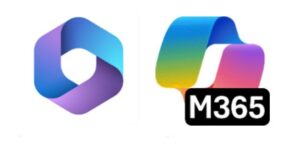
If you thought Microsoft’s Copilot branding already was hard to decipher, get ready for more confusing changes. As of mid-Jan. 2025, Microsoft will be shifting its Copilot branding and delivery in ways that also will affect Windows and the Microsoft 365 app.
A quick recap: Microsoft already had muddied the branding waters by referring to both the former Bing Chat and Bing Chat Enterprise experiences as “Microsoft Copilot.” The main difference between the two was that Bing Chat Enterprise required users to sign in with their Entra IDs to get more functionality and a level of data protection for end users.
Bing Chat Enterprise = Microsoft 365 Copilot Chat
As of Jan. 2025, Microsoft will rebrand the Bing Chat Enterprise version of Microsoft Copilot as “Microsoft 365 Copilot Chat.” Just to be (un)clear, Microsoft 365 Copilot Chat is different from Microsoft 365 Copilot Business Chat — the Microsoft 365 Copilot UI feature formerly known as Microsoft 365 Chat.
Microsoft 365 Copilot Chat, just like its Bing Chat Enterprise predecessor, will be available to those who sign in with their Entra ID accounts. As of Fall 2024, Bing Chat Enterprise included “Enterprise Data Protection” (EDP) instead of Commercial Data Protection. EDP adds prompt and response retention and guarantees that prompts and responses will stay in the Microsoft 365 service boundary.
In addition to providing EDP, the Microsoft 365 Copilot Chat “will allow end users to discover, create, and use agents,” according to Microsoft. Agents, such as those that access shared work data, will be billed based on metered consumption for users without a Microsoft 365 Copilot license, which is not a significant change from the current model. Agents grounded only on web data will be available to use at no additional cost, Microsoft says. (We’ve asked about agent creation and how that will work for those without a Microsoft 365 Copilot license; no word back yet from Microsoft.)
Update – Dec. 20: “Agent use will be billed based on metered consumption through Copilot Studio” starting in Jan. 2025, a spokesperson verified.
In spite of all of these changes, Microsoft 365 Copilot Chat will remain free, rather than sell for $30 per user per month like Microsoft 365 Copilot does. So it’s Microsoft 365 in name (not licensing or pricing) only.
Update (Jan. 15, 2025): Microsoft re-announced Microsoft 365 Copilot Chat, emphasizing its ability to consume and create agents. M365 Copilot Chat seemingly is the “freemium” tier of Microsoft 365 Copilot; it’s free for those signing in with Entra IDs, but will require users to set up Pay-As-You-Go (PAYG) licensing and use Copilot Studio metering to consume and create agents that access work data.
Microsoft 365 app = Microsoft 365 Copilot app
Microsoft also is going to rebrand the Microsoft 365 app (the Windows and web apps that allow users to access OneDrive and Office apps) as the “Microsoft 365 Copilot app” even though only some of its users will have paid for Microsoft 365 Copilot. The changes to the Microsoft 365 app are slated to happen starting in mid-January and to roll out gradually to all users. (Microsoft earlier this year announced it will replace the Copilot mobile apps with the Microsoft 365 Copilot app.)
As part of this change, Microsoft will be dropping the existing Microsoft 365 app icon and replacing it with a new “Microsoft 365 Copilot” app icon, which features the Microsoft 365 Copilot logo. (See screen shot embedded in this post which compares the current icon and the new icon.) Microsoft also will be moving existing elements, like the header, in the current app and eliminating some components (such as “My Day”) as part of the move to put AI features front and center.
The changes to the Microsoft 365 app are slated to happen starting in mid-January and to roll out gradually to all users.
As part of this wave of rebranding moves, Microsoft is planning to introduce a new URL “to make it easier to discover Microsoft 365 Copilot on the web”: M365Copilot.com. And those who go to office.com and microsoft365.com will automatically redirect to m365.cloud.microsoft. (These new URLs are not yet live, as of mid-Dec. 2024.)
Yet More Copilot Changes for Windows
Earlier this year, Microsoft abandoned its 2023 plans to integrate Copilot with Windows so that it could help users perform certain Windows tasks (such as turning on dark mode) and ultimately with other non-Windows-specific tasks in Office and other apps. Microsoft unbundled Copilot from Windows and instead, made it available as a Progressive Web App (PWA) that was little more than the Copilot (Bing) website in Edge.
In another shift announced in early Dec. 2024, Microsoft is making the Microsoft Copilot app for Windows only available to consumer users authenticating with a Microsoft account; it no longer works for business users authenticating with a Microsoft Entra account. This means admins are going to need to take extra steps if they want employees authenticating with Entra to access Copilot via the Copilot key that Microsoft and PC makers are including in keyboards for new devices.
Microsoft currently is testing the latest iteration of its Copilot app for Windows with Windows Insider testers. The current “native” Copilot app still just provides a view of the Copilot web site, however.
These rebrandings and repositionings cap off a year of flux for Microsoft’s various Copilots. Microsoft’s lack of a cohesive, consistent strategy around this set of technologies should inspire caution among commercial customers. Even though Microsoft is betting its business on Copilots and related AI technologies, customers who opt to do so at this early stage should be prepared for lots of changes and uncertainty.
Related Resources
Microsoft’s Copilot with Data Protection to get prompt retention and more
M365 Copilot Business Chat: The rebranding continues
Evolving the Copilot key experience for commercial organizations
The new ‘native’ Copilot app for Windows goes to testers

Microsoft has quietly changed direction with Fabric and Power BI licensing and is now only deprecating Power BI Premium P subscriptions at the end of 2025. Customers using the Power BI embedded SKUs (known as A and Premium EM) can breathe a sigh of relief, as the specter of significant cost increases next year has been vanquished.
What Is Power BI Embedded?
For several years, the Power BI service has provided two licensing options for customers who want to use the service to deliver reports to their own applications, like warehouse displays that show performance metrics or an internal Web application that shows daily sales levels. These options, known as Azure Power BI Embedded A SKUs and Power BI Premium EM SKUs, provide back-end hosting and delivery only, which is ideal for delivering reports to custom applications. However, the services do not include front-end user access through the Power BI portal or mobile applications, which means they are not a replacement for the other services like Premium P and Power BI Pro.
The real advantage of the embedded options is for the right scenario, they are lower-cost. The services have a lower price point and only require Power BI user licensing for report creators, not for consumers.
The Problem Was the Cost of User Licensing
In Mar. 2024, I wrote about how Power BI customers are being forced into Fabric licensing, when Microsoft announced the retirement of several Power BI licensing options by the end of 2024, including Premium P and Power BI embedded, which included Premium EM and A. (The announcement is still available although all references to the retirement of Power BI embedded have been removed, along with all comments.)
As part of that announcement, the company said that because Fabric is compatible with Power BI embedded (which it is) it would be the new licensing option for Power BI embedded workloads. The new F SKUs match up well with the existing EM and A SKUs both in performance and price when using capacity reservations, which you can find in Microsoft’s comparison table:
- F8 = EM1 and A1
- F16 = EM2 and A2
- F32 = EM3 and A3
- F64 = A4.
The cost problem arose because F SKUs below F64, which include F8, F16, and F32, require Power BI user licensing for report consumers. Under the original EM and A SKUs there is no Power BI user licensing required for those report consumers.
So, imagine a company currently using Premium EM as a solution to show performance metrics on displays in a warehouse with 200 workers. Using an EM1 SKU, the company pays US$625 per month.
Under a comparable F8 SKUs the same solution would cost US$625 per month for the F8 subscription and an additional US$2,000 per month for 200 Power BI Pro subscriptions to cover the workers who would see the displays. An increase of 420%.
A Change of Heart
It looks to me like sometime during the summer of 2024, perhaps while on vacation, some reasonable Microsoft officials read all the comments and listened to customer feedback and decided this wasn’t a good idea.
There were no big announcements highlighting the change of direction in Power BI embedded licensing or the change of heart over Power BI Report Server rights that I wrote about here. However, when Microsoft revamped the original blog post and we were able to verify the situation through other internal Microsoft sources, I was able to do something that rarely happens: I gave customers good news about Microsoft licensing.
Related Resources
Fabric is discussed in the Database, Analytics, and AI Roadmap (Directions members only)
Power BI is discussed in the Database, Analytics, and AI Roadmap (Directions members only)

Window 10 leaves support on Oct. 25, 2025. That’s less than one year. After this date it will be necessary to obtain Extended Security Updates (ESUs) to continue to receive critical and important security updates. All of which sounds good until you do some analysis.
One year ahead of the end of support for Windows 10, Global Stats StatCounter estimates that Windows 10 comprises approximately 61% of all Windows client versions. Estimates are that Windows 10 and 11 are running on 1.4 billion devices. It is not clear what percentage of these devices are running in enterprises and what percentage are being used by consumers, but it appears that both categories mostly use Windows 10.
Assume that enterprises — the largest businesses — plan to get to Windows 11 before the end of support for Windows 10.
That still leaves a significant number of small and medium businesses, government entities and NGOs, and an immense number of consumers still running Windows 10. Many of them have no intention of migrating to 11 unless their existing Windows 10 PC breaks (any replacement will have Windows 11 preinstalled). But devices are more reliable than the operating systems that run on them so Windows 10, like Windows 7, and Windows XP before it, will be around for a long time.
However, for the first time ever, Microsoft is making ESUs available to consumers. Only available for one year, this extends support out until 2026 – unless Microsoft decides it’s important to extend this offer for another year or two —but only for those people willing to give Microsoft USD$30.
Will Consumers Bite?
It appears Microsoft believes people who have resisted all the previous enticements to move to Windows 11 will decide to send Microsoft money for the additional updates. These people have already shown they are unwilling to purchase Windows 11 compatible hardware or are unhappy with the changes to Windows 11 that seem just arbitrary and capricious. There is already resistance to installing updates given the view many Windows users have that Microsoft’s updates, including security updates, often have problems that range from annoyances to blue screens of death.
All of this means that adoption of ESUs by consumers will be very low. And this means that the Windows ecosystem, as Microsoft likes to call it, will be filled with devices just waiting to be turned into bots capable of wreaking havoc on those of us who keep their devices up-to-date and hopefully adequately protected against vulnerabilities in the OS.
This isn’t a hypothetical scenario; there is precedent for this concern. Ars Technica recently reported that thousands of hacked TP-Link routers were used in years-long account takeover attacks. Microsoft acknowledges it has “observed intrusion activity targeting and successfully stealing credentials from multiple Microsoft customers that is enabled by highly evasive password spray attacks.” Small Office Home Office (SOHO) “routers manufactured by TP-Link make up most of this network”. The vast numbers of vulnerable devices mean the bad actor can continually move between compromised devices to avoid detection.
Now Microsoft is poised to add millions of unpatched Windows 10 devices to the mix — devices that will be capable of being compromised and turned against all the users of the Internet, not just the Windows ecosystem.
But What About Those Tempting ESU Revenues?
The money Microsoft will make on ESUs from consumers will likely be a rounding error on its annual report. But by not providing a compelling reason to upgrade to Windows 11 and charging for ESUs for Windows 10, it is leaving the potential for bad actors to create attacking botnets. Botnets attacking Microsoft’s enterprise customers and others.
Enterprises are another story. Microsoft could make some real money by charging businesses for Windows 10 ESUs. In year one, Microsoft is charging commercial customers USD $61 per device for Windows 10 ESUs for the first year, with the price doubling Years 2 and 3. Microsoft is charging educational institutions USD$1 per device for Windows 10 ESUs for Year 1, with the price doubling Years 2 and 3.
Microsoft asserts its Secure Future Initiative is about doing the right thing for security. But I fail to see how charging consumers who won’t pay additional monies to support an OS they feel they have the right to use in perpetuity helps create a secure future at all. The best thing for everyone’s security and peace of mind is to just make the updates available for free, via Windows Update.
Related Resources
Microsoft confirms Windows 10 Extended Security Updates are coming in 2025
Consumers Get $30 Windows 10 ESU Offer (But Only for a Year)
High time for another sweeping Microsoft security initiative?

Just days ahead of its Ignite 2024 conference for IT pros and partners, Microsoft announced some major changes to its price list and its Enterprise Agreement volume licensing framework that will take effect starting in late 2024 and into 2025.
On December 1, 2024, Microsoft will add a new monthly billing option for Microsoft 365 Copilot, Copilot for Sales and Copilot for Service. Touted by Microsoft as helping customers with “cash flow flexibility,” the new billing option will allow customers to commit to an annual subscription and pay monthly rather than entirely up-front. But if customers opt for this monthly plan, they will pay 5% more for these products than if they paid once for the full year.
It’s important to note that Microsoft is not offering customers the option of paying monthly but licensing these Copilots for less than a full year — which is actually what many customers would prefer. Microsoft will continue to require customers to license its business Copilots for a full year minimum, whether they pay monthly or annually.
It’s not just Copilots which will be getting this new, pricier financing option. Starting April 1, 2025, Microsoft will be increasing prices for other products licensed via per-user monthly billing plans for annual term subscriptions across CSP, MCA-E and “Buy Online.” All new and renewing monthly billing plans for these annual subscriptions will be priced 5% higher than if paid for annually under annual subscription plans.
Product categories which will be covered by the 5% higher monthly billing option include Microsoft 365, Office 365, Enterprise Mobility + Security, Windows 365, Dynamics 365, Power Platform and other online services. (Products not affected by the price increase for monthly billing include on-premises software, plus Azure Reserved Instance/Savings Plan, Marketplace, GitHub and AirGap, according to Microsoft’s Frequently Asked Questions document on the changes.)
Customers with renewals before April 1, 2025, will be able to lock their price without paying a 5% uplift until their anniversary date. Any customers who want to change to an annual billing plan, which is priced 5% lower than the updated monthly billing option, for their annual subscription can do so at their next renewal date after April 1, 2025, the FAQ says.
Price increases coming for Teams Phone, Power BI
Starting April 1, 2025, Microsoft also is increasing prices for a handful of products purchased as annual term subscriptions paid once annually. Teams Phone Standard, Power BI Pro and Power BI Premium Per User all are getting price hikes of 15% to 40% for both new and existing customers upon renewal.
Microsoft officials said they believed the price increases were warranted due to the extra value Microsoft has added to these products since their introduction a few years ago.
The new prices for those paying annually for a one-year subscription — plus a few existing prices for comparison:
• Teams Phone Standard: USD$10 per user, per month (was $8)
• Teams Phone Standard for Frontline Workers: USD$5 per user, per month (was $4)
• Teams Phone with pay-as-you-go calling (for users in UK/CAN): USD$12 per user, per month
• Teams Phone with pay-as-you-go calling (for users in US & all other service markets): USD$13 per user, per month
• Teams Phone with Calling Plan (for customers in US/UK/CAN): USD$17 per user, per month (was $15)
• Teams Phone with Calling Plan (for customers outside US/UK/CAN): USD$22 per user, per month
• Teams Phone with domestic and international calling: USD$34 per user, per month
• Power BI Pro licenses: USD$14 per user, per month (was $10)
• Power BI Premium Per User licenses: USD$24 per user, per month (was $20)
Customers will be billed another 5% more for these products if purchased on a monthly billing plan per annual subscription.
Microsoft notes in its FAQ that “currently” there are no pricing changes for customers who purchase Power BI Pro or Teams Phone through Microsoft 365 E5 or Office 365 E5 annual term subscriptions with annual billing.
Speaking of E5, starting Jan. 1, it is offering partners a promotion of 15% off the net price of Microsoft 365 E5 for an annual commitment for new customers buying 1-2,400 licenses through June 30, 2025.
The push to move smaller/mid-size orgs off EAs begins
In addition to these price changes, Microsoft also is going to start moving some organizations off Enterprise Agreements and over to Microsoft Customer Agreements for Enterprise (MCA-E) or Cloud Solution Provider (CSP) agreements. Microsoft officials said this will affect “a small percentage of cloud Enterprise Agreements in direct markets,” which will no longer be eligible for renewal under their existing EAs, and that it would begin notifying affected customers of the coming change during January 2025.
Directions on Microsoft shared an early warning about this coming change in June in a blog post entitled “Mid-size orgs: Your Enterprise Agreement days are numbered.” As we noted at that time, Microsoft has been working to move smaller organizations off EAs for years. But Directions heard that Microsoft was planning to try to eliminate the EA option for companies with fewer than 2,400 users/devices (known as Level A) by moving them to MCA-based licensing.
(It’s not clear from Microsoft’s November blog post about the licensing changes exactly which categories of customers will be forced to move off of EAs in 2025, but the wording indicates it’s likely smaller/mid-size customers.)
While Microsoft unsurprisingly characterizes the EA-to-MCA-E/CSP change as positive, customers will lose some of the benefits they have under EAs when they move to the new agreements. In some cases, customers will need to string together multiple license types to try to approximate the pricing and benefits they get with EAs.
“Customers now forced to move from EA to MCA are going to have a bunch of unwelcome surprises,” said Directions on Microsoft analyst Rob Horwitz.
Additionally, customers who are required to go from an EA to an MCA-based license may be considered a “net-new” customer by Microsoft. That means, under MCA, they could be required to buy Microsoft 365 E3/E5 without Teams and buy Teams separately, which will add a few dollars per user per month. CSPs may be able to help some orgs renew existing subscriptions with Teams but won’t be able to help customers moving from EA to CSP to buy brand-new subscriptions with Teams.
Update (Nov. 15): We asked Microsoft for more clarity on the changes around Teams. A spokesperson gave us the following updated information.
Microsoft is providing CSP customers whose renewal dates are after April 2025 two options for keeping their Microsoft 365 suites with Teams.
- Renew their annual subscription with monthly billing and pay the 5% uplift.
- Renew their annual subscription with annual billing without any price increase.
Customers will lose Teams in their bundles if they change their annual billing from an annual subscription to monthly billing or monthly billing from an annual subscription to monthly billing for a monthly subscription.
Related Resources
Microsoft blog post on pricing, partner changes (Nov. 2024)
Pricing, partner changes: Microsoft’s FAQ (download link)
Pricing updates for Power BI, Teams Phone
Directions Blog: Mid-size Orgs – Your EA Days Are Numbered
Directions Blog: MCA Could Become Your Only Option for an Azure Consumption Agreement

Microsoft’s biggest conference of the year, Ignite, traditionally includes announcements for IT professionals and enterprise developers. This year, the show, happening the week of November 18 in Chicago, also is serving as Microsoft’s partner conference. (Microsoft already dropped a few partner-related bombshells ahead of the show around Enterprise Agreement licensing changes and coming price hikes.)
Unsurprisingly, Microsoft is touting AI, Copilots, and agents as the biggest news at Ignite. But there are a number of other Ignite announcements which could figure in enterprise customers’ and partners’ plans for 2025.
Copilots, Agents, and Actions
At Ignite, Microsoft isn’t expected to talk up its OpenAI partnership as much as it has in recent events. Instead, the emphasis will be on what Microsoft is doing for developers and customers in the AI realm.
Microsoft is making more incremental additions to the existing Microsoft Copilot 365 assistants —in Teams, Excel, PowerPoint, OneNote, and Outlook. Officials also seem to be trying to bring some clarity to Microsoft’s various AI- assistant categories which include Copilots, agents, autonomous agents, and Copilot Actions.
Microsoft announced the concept of autonomous agents in October 2024. Autonomous agents can do things like detect an email arriving, respond and then use AI to trigger a set of associated business processes like looking up the sender’s details, see priori communications, check inventory, etc.
Now, Microsoft is starting to roll out agents in Microsoft 365, which will complement the autonomous agents already announced for sales, service and supply chain. At Ignite, it is highlighting some of the Microsoft-built agents, such as SharePoint agents (already available); Interpreter in Teams for real-time speech-to-speech translation (public preview coming in early 2025); and employee self-service, starting with HR and IT (in private preview). Customers can build agents inside Copilot Studio (the product formerly known as Power Virtual Agents).
Not to be confused with agents, Copilot Actions in Microsoft 365 Copilot, currently in private preview, are meant to automate everyday tasks with simple, fill-in-the-blank prompts. They can do things like automatically generate a summary of action items at the end of a day; set a reminder to ask team members for input; or summarize the last few interactions you’ve had with someone before you meet with them.
As it seems to be doing constantly, Microsoft also is doing more AI rebranding. The Azure AI Studio platform is now part of a more comprehensive platform known as Azure AI Foundry. AI Foundry includes the existing Azure AI Studio portal, a software development kit (now in preview) and an AI Agent Service (due to hit preview in December). Microsoft is positioning AI Foundry as being a central place for building, deploying and managing AI apps and agents. At the same time, Microsoft is more tightly integrating Copilot Studio and AI Foundry to enable “more complex, custom scenarios” in Copilot Studio.
Directions‘ Top Picks
In no particular order, here are Directions on Microsoft’s additional top picks for what’s important for enterprises at Ignite this year:
Power Platform gets more pro-dev power. Microsoft is taking steps to make its low-code Power Platform tools more appealing to pro developers (as opposed to citizen devs/”makers”) by building more complicated tasks and apps. (Maybe as a way to answer the question “Why do I need a no-code/low-code platform when I now have GitHub Copilot and other AI assistants?”) At Ignite, Microsoft is talking up how to build complex solutions by using the Copilot feature in Power Apps. It also is emphasizing new AI and governance features in Power Automate Copilot.
Purview becomes even more of a must-have. Microsoft increasingly is touting its Purview governance/compliance family as being irreplaceable when it comes to securing data and preventing data oversharing with Copilot for Microsoft 365, as well as other products like Fabric, Power Automate and Security Copilot. Purview is going to get built-in integration with Copilot Studio (a capability now in preview) to provide data security and compliance features to low-code developers building custom AI apps — a move which fits in with Microsoft’s evolving positioning of Power Platform as more than just a way to build simple apps.
Data Loss Prevention (DLP) for Microsoft 365 Copilot, which is in preview, is meant to help ensure that the content within sensitive documents is not summarized by Microsoft 365 Copilot or processed by Microsoft 365 Copilot for grounding data.
More Windows Security, Safeguards
Coming new Windows security features. In response to the CrowdStrike meltdown this year, which resulted in many Windows PCs being unusable due to a faulty update from security vendor CrowdStrike, Microsoft is planning to add new features to Windows in 2025. “New Windows capabilities” are coming in private preview for its security partners in July 2025 which will allow them to build their products outside of kernel mode and run in user mode like apps do, the company says, without providing specifics.
A new feature called administrator protection, currently in preview, will give users standard user permissions by default but still allow for system changes, like app installation, on their PCs when needed. The feature will allow Windows to create a temporary isolated admin token which will be destroyed immediately once a task is complete. Another coming Windows feature, known as Quick Machine Recovery, will be available to Windows Insider testers in early 2025. This feature will enable IT Administrators to execute targeted fixes from Windows Update on PCs, even when machines are unable to boot, without needing physical access to the PC.
Hotpatching for Windows client. Hotpatch in Windows, currently in preview, will be added to Windows 11 Enterprise 24H2 and Windows 365. Similar to Hotpatching for Windows Server, this feature will reduce the number of reboots users have to do each year from 12 to 4 when applying patches.
Unstacking Azure Stack
Azure Local replaces Azure Stack. Azure Local is the new brand name for everything formerly known as Azure Stack (software and appliances for edge, datacenter and more under the Azure Stack Edge, Hub, and HCI monikers.) Microsoft calls Local a “hybrid infrastructure platform enabled by Azure Arc.” Microsoft plans to continue making components of the Local platform available through select partners like Dell, HP and Lenovo across industrial PCs and servers.
The Azure Stack HCI (Hyperconverged Infrastructure) offering is being folded into Local. Microsoft says: “At launch, existing Azure Stack HCI customers will automatically upgrade to Azure Local, which offers much broader capabilities than what they currently use today. Key features include customizable cloud-based operations and security, supporting both cloud-native and traditional apps with Azure Virtual Desktop integration.” Microsoft has been noticeably mum about the next version of Azure Stack HCI; this Local news is evidently why.
The next version of SQL Server. SQL Server 2025, now in private preview, is an enterprise-ready vector database, Microsoft says, and will support AI apps from on-premises to cloud. It will allow customers to run generative AI models using their own data and provide model management via Azure Arc.
Fabric Databases. Microsoft is adding a new workload to its Fabric analytics platform. Fabric Databases, now in preview, brings transactional databases natively to Fabric for app developers. SQL database, the first available in Fabric, is built on the SQL Server engine. Also on the roadmap: Azure Cosmos DB and Azure Database for PostgreSQL.
Windows 365 Thin Client: Coming in April
Link thin-client device for Windows 365. Microsoft is previewing a new thin client called Windows 365 Link, which is designed to connect securely to Windows 365 in seconds. The Link device, which will be available for purchase in select markets starting in April 2025 for $349, is aimed at frontline workers and bring-your-own-device employees. There’s no information so far on which OEM(s) is/are building Link or whether it will be branded as Surface when it goes on sale. (Fun fact: Microsoft has been working on some kind of Windows 365 device-based solution since at least 2022.)
Related Resources
Microsoft to Add New Monthly Billing Option, But at a 5% Premium
Microsoft’s Copilot Wave 2: Your Cheat Sheet (October 2024)
Four Lessons Microsoft Customers Can Learn From the CrowdStrike Meltdown
From 2022: New Subscription-Powered Windows 365 Devices in the Works

Microsoft announced plans in March for Office Long Term Servicing Channel (LTSC) 2024. On September 16, a bit earlier than many expected, Microsoft began making Office LTSC 2024 available for purchase by existing commercial and government volume-licensed customers. Microsoft will make Office LTSC available for purchase by all customers, including consumers, beginning October 1.
Office LTSC 2024, because it is an on-premises product, does not include cloud functionality around collaboration, automation, cloud-backed security and compliance, and Copilot capabilities.
It is an updated bundle of Word, Excel, PowerPoint, Outlook, OneDrive, OneNote and Access (which is available on Windows only). Microsoft also is making new on-premises version of Project and Visio available starting today. Office LTSC 2024 will not ship with Microsoft Publisher, which is being retired, or with the Microsoft Teams app, which is available to download separately. The Office LTSC 2024 apps can be installed on one PC (running Windows 10, Windows 10 LTSC or Windows 11) or Mac, and support for Web apps is not included.
Five years of mainstream support only
As an LTSC product, Office LTSC 2024 gets security updates only, not new features as they become available. The product is covered under device-based licensing only. Microsoft will provide support for Office LTSC 2024 for five years only (with no Extended support available) and can be used alongside Microsoft 365 Apps for Enterprise in hybrid environments.
Previously, Microsoft execs said the 16- and 32-bit Office LTSC 2024 versions — Office LTSC Professional Plus, Office LTSC Standard, as well as the individual apps in the suite — will be up to 10 percent more expensive than the 2021 version. Microsoft is not planning to increase the price for the consumer Office 2024 release, officials said.
Microsoft officials have said there will be at least one more perpetual/non-subscription release of Office after Office LTSC 2024. If the company sticks to its current cadence, that release could be available around 2027.
Related Resources
Office LTSC 2024 is now available
Microsoft’s subscription-free, ‘perpetual’ Office LTSC 2024 to ship this year